Assessment ERouting Final – CCNA 2 Exploration: Routing Protocols and Concepts (Version 4.0)
1. Refer to the exhibit. The network consists of hundreds of routers branched from connected regional distribution sites using single area OSPF. Recent network failures caused packet flooding and route recalculations in all branch networks. What should the engineer do to minimize the effect of the routing instabilities?
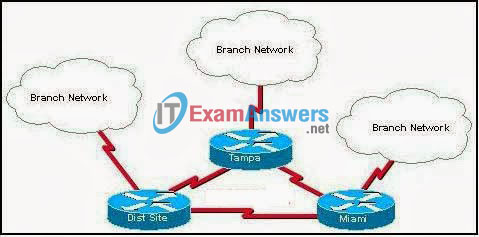
- Adopt RIPv2 which is not subject to packet flooding.
- Implement static routing.
- Implement a mix of routing protocols to contain the instabilities.
- Change the topology to a heirarchical design which puts each branch network in its own area.
2. Refer to the routing table shown in the exhibit. What is the meaning of the highlighted value 192?

- It is the value assigned by the Dijkstra algorithm that designates the number of hops in the network.
- It is the value used by the DUAL algorithm to determine the bandwidth for the link.
- It is the metric, which is cost.
- It is the administrative distance.
3. Which three statements are true regarding the encapsulation and de-encapsulation of packets when traveling through a router? (Choose three.)
- The router modifies the TTL field, decrementing it by one.
- The router changes the source IP to the IP of the exit interface.
- The router maintains the same source and destination IP.
- The router changes the source physical address to the physical address of the exit interface.
- The router changes the destination IP to the IP of the exit interface.
- The router sends the packet out all other interfaces, besides the one it entered the router on.
4. Which of the following are required when adding a network to the OSPF routing process configuration? (Choose three.)
- network address
- loopback address
- autonomous system number
- subnet mask
- wildcard mask
- area ID
5. The command ip route 192.168.2.0 255.255.255.0 172.16.2.2 was entered into the router. After network changes were made, the new next hop for the 192.168.2.0/24 network is 172.16.5.1. What should an administrator do so that the router will use the new next hop to reach the 192.168.2.0 network?
- Enter the command clear ip route *.
- Lower the administrative distance for the new path to ensure that it is used first.
- Negate the original command and enter a new static route with the new next hop.
- Nothing. The router will learn of the new next hop and automatically update the route table.
6. When would the network administrator use the ip bandwidth-percent eigrp as-number percent command?
- when there is a low bandwidth connection
- when the connection is on a shared medium
- when the connection is serial instead of Ethernet
- when the link is always busy
7. A router in an EIGRP enterprise network has a default route configured via the interface that connects to the ISP. Which command would the network administrator apply on this router so that other routers in the EIGRP AS 100 network will use this default route?
- redistribute static
- redistribute eigrp 100
- redistribute connected
- default-information originate
8. What is the purpose of the TTL field within an IP packet header?
- clears an unreachable route from the routing table after the invalid timer expires
- prevents regular update messages from inappropriately reinstating a route that may have gone bad
- removes an unreachable route from the routing table after the flush timer expires
- limits the period of time or number of hops a packet can traverse through the network before it should be discarded
- used to mark the route as unreachable in a routing update that is sent to other routers
9. Refer to the exhibit. How many routes are both level 1 and qualify for use as an ultimate route?
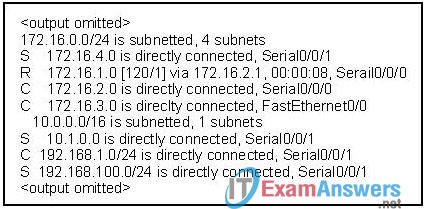
- 1
- 2
- 3
- 4
- 5
- 6
10. Refer to the exhibit. Cost for each path are shown. If all routers are configured to use OSPF, what would be the path of a packet sent from Router C to Router D if Router A was down?
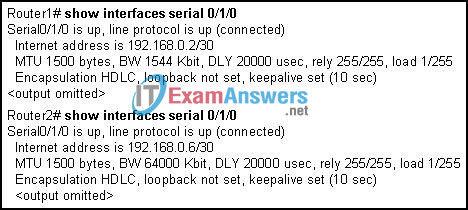
- C-B-E-D
- C-B-A-D
- C-F-E-D
- C-F-B-A-D
- C-F-E-A-D
11. Refer to the exhibit. Routers 1 and 2 are directly connected over a serial link. Pings are failing between the two routers. What change by the administrator will correct the problem?
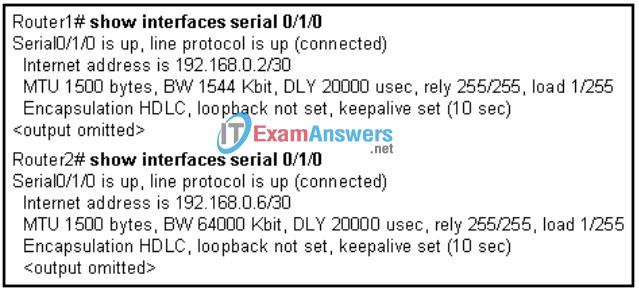
- Set the encapsulation on both routers to PPP.
- Decrease the bandwidth on Serial 0/1/0 on router 2 to 1544.
- Change the cable that connects the routers to a crossover cable.
- Change the IP address on Serial 0/1/0 on router 2 to 192.168.0.1/30.
12. Refer to the exhibit. A network administrator is trying to determine why router JAX has no OSPF routes in its routing table. All routers are configured for OSPF area 0. From the JAX router, the administrator is able to ping its connected interfaces and the Fa0/1 interface of the ORL router but no other router interfaces. What is a logical step that the network administrator should take to troubleshoot the problem?
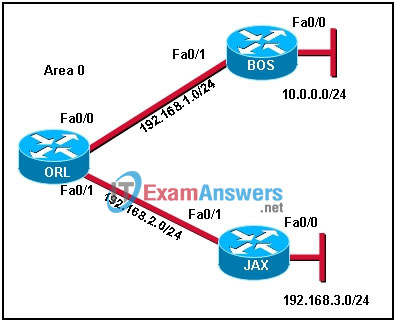
- Reboot the routers.
- Change the OSPF process ID on all of the routers to 0.
- Check to see if the cable is loose between ORL and JAX.
- Check to see if CDP packets are passing between the routers.
- Use show and debug commands to determine if hellos are propagating
13. A router boots and enters setup mode. What is the reason for this?
- The IOS image is corrupt.
- Cisco IOS is missing from flash memory.
- The configuration file is missing from NVRAM.
- The POST process has detected hardware failure.
14. Refer to the exhibit. R1 is configured properly for a single area OSPF, and R2 has been recently installed in the network. Which set of commands is required to configure a single area OSPF for the networks that are connected to R2?

- R2(config)# router ospf 1
R2(config-router)# network 192.168.2.0 0.0.0.255 area 0
R2(config-router)# network 10.1.1.0 0.0.0.3 area 0 - R2(config)# router ospf 1
R2(config-router)# network 192.168.2.0 0.0.0.255 area 0
R2(config)# router ospf 2 R2(config-router)# network 10.1.1.0 0.0.0.3 area 0 - R2(config)# router ospf 1
R2(config-router)# network 192.168.2.0 0.0.0.255 area 0
R2(config-router)# network 10.1.1.0 0.0.0.3 area 1 - R2(config)# router ospf 1
R2(config-router)# network 192.168.2.0 0.0.0.255 area 0
R2(config-router)# network 10.0.0.0 0.0.0.3 area 1
15. Which two technologies can be used in distance vector routing protocols to prevent routing loops? (Choose two.)
- authentication
- link-state advertisements
- hold-down timers
- Spanning Tree Protocol
- split horizon
16. Refer to the exhibit. If the attached device is configured correctly, what action can be taken to change the state of FastEthernet0/0 to Up Up?

- Attach a crossover cable to the interface.
- Change the encapsulation on the interface to HDLC.
- Issue the no shutdown command for the interface.
- Set the clock rate for the interface to 56000.
17. Refer to the exhibit. A network administrator configures a static route on router R1 to reach the 192.168.1.0/24 network. Which IP address should be used as the next-hop address in the ip route command?

- 192.168.1.1
- 192.168.2.1
- 192.135.250.1
- 192.135.250.2
18. Which routing protocol maintains a topology table separate from the routing table?
- IGRP
- RIPv1
- RIPv2
- EIGRP
19. A router has learned two equal cost paths to a remote network via the EIGRP and RIP protocols. Both protocols are using their default configurations. Which path to the remote network will be installed in the routing table?
- the path learned via EIGRP
- the path learned via RIP
- the path with the highest metric value
- both paths with load balancing
20. Refer to the exhibit. The hosts that are connected to R2 are unable to ping the hosts that are connected to R1. How can this problem be resolved?
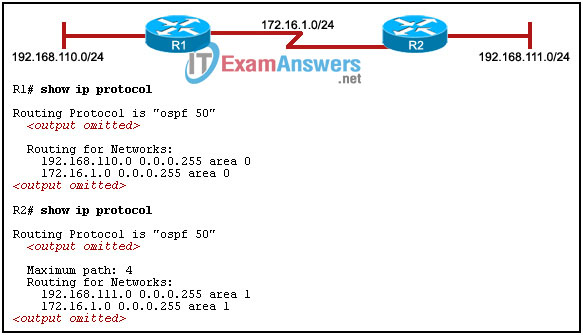
- Configure the router ID on both routers.
- Configure the R2 router interfaces for area 0.
- Configure a loopback interface on both routers.
- Configure the proper subnet masks on the router interfaces.
21. Two routers need to be configured within a single OSPF area. Which two components need to be configured on both routers to achieve this? (Choose two.)
- the same process ID
- the same area ID
- network addresses and wildcard masks
- the same router ID
- the same loop back address
22. Refer to the exhibit. Which two interface variables will determine the metric that is used on EIGRP routes? (Choose two.)
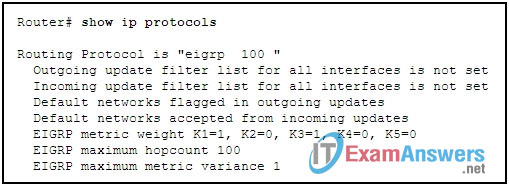
- load
- delay
- reliability
- hop count
- bandwidth
23. A network administrator is in charge of two separate networks that share a single building. What device will be required to connect the two networks and add a common connection to the Internet that can be shared?
- hub
- router
- access point
- Ethernet switch
24. Which feature of RIPv2 enables it to function as a classless routing protocol?
- Subnet masks are included in routing updates.
- Routing updates are triggered by topology changes.
- Next-hop addresses are included in routing updates.
- Multicast addresses are used to send routing updates.
25. Refer to the exhibit. Two connected routers are unable to establish adjacency. Based on the show ip ospf interface output, what could be the problem?
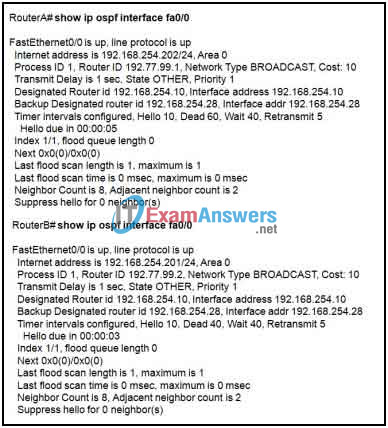
- The dead timers do not match.
- The routers have not reached full state.
- The two routers are in different autonomous systems.
- The physical interface between the two routers is down.
26. In a lab test environment, a router has learned about network 172.16.1.0 through four different dynamic routing processes. Which route will be used to reach this network?
- D 172.16.1.0/24 [90/2195456] via 192.168.200.1, 00:00:09, Serial0/0/0
- O 172.16.1.0/24 [110/1012] via 192.168.200.1, 00:00:22, Serial0/0/0
- R 172.16.1.0/24 [120/1] via 192.168.200.1, 00:00:17, Serial0/0/0
- I 172.16.1.0/24 [100/1192] via 192.168.200.1, 00:00:09, Serial0/0/0
27. Which statement is true about the metrics used by routing protocols?
- A metric is a value used by a particular routing protocol to compare paths to remote networks.
- A common metric is used by all routing protocols.
- The metric with the highest value is installed in the routing table.
- The router may use only one parameter at a time to calculate the metric
28. What is the key responsibility of the switching function within a router?
- to choose the best path based on the lowest path cost
- to encapsulate packets in the correct data link frame type
- to look up the correct exit interface for the destination IP address
- to look up the correct exit interface for the destination MAC address
- to resolve the destination IP address into a destination MAC address
29. Refer to the exhibit. All routers are properly configured with default configurations and are running the OSPF routing protocol. The network is fully converged. A host on the 192.168.3.0/24 network is communicating with a host on the 192.168.2.0/24 network. Which path will be used to transmit the data?
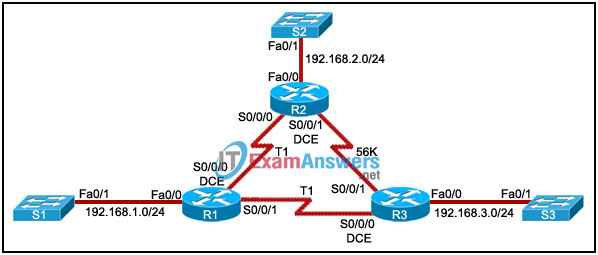
- The data will be transmitted via R3-R2.
- The data will be transmitted via R3-R1-R2.
- The traffic will be load-balanced between two paths — one via R3-R2, and the other via R3-R1-R2.
- The data will be transmitted via R3-R2, and the other path via R3-R1-R2 will be retained as the backup path.
30. Refer to the exhibit. How many routes are ultimate routes?
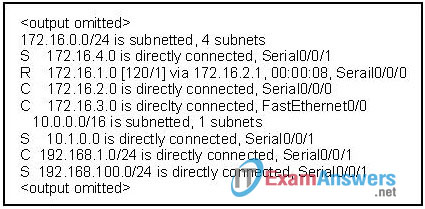
- 3
- 4
- 5
- 7
31. Refer to the exhibit. Both routers are using the RIPv2 routing protocol and static routes are undefined. R1 can ping 192.168.2.1 and 10.1.1.2, but is unable to ping 192.168.4.1. What is the reason for the ping failure?
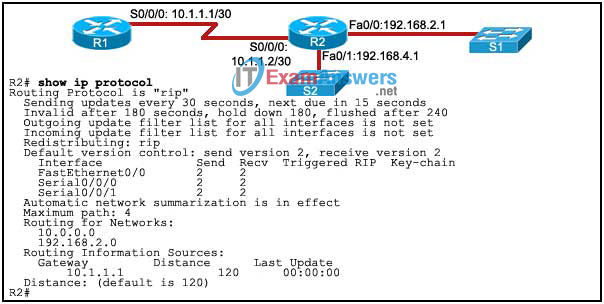
- The serial interface between two routers is down.
- R2 is not forwarding the routing updates.
- The 192.168.4.0 network is not included in the RIP configuration of R2.
- RIPv1 needs to be configured.
32. Which two statements are true about the EIGRP successor route? (Choose two.)
- It is saved in the topology table for use if the primary route fails.
- It may be backed up by a feasible successor route.
- It is used by EIGRP to forward traffic to the destination.
- It is flagged as active in the routing table.
- After the discovery process has occurred, the successor route is stored in the neighbor table
33. Refer to the exhibit. Hosts on the 192.168.1.0 network cannot communicate with hosts on the 172.16.1.1 network. The network administrator has run the show ip route command on R1. What could be the cause of this problem?
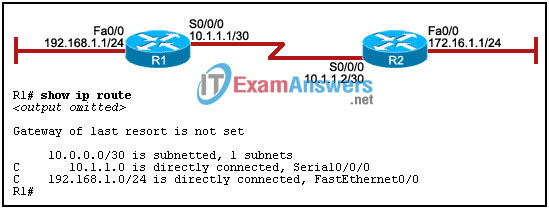
- The FastEthernet interface on R1 is disabled.
- Autosummarization is enabled on R1.
- The serial interface S0/0/0 of R1 is administratively down.
- No static route or routing protocol is configured.
34. Refer to the exhibit. The network is configured for RIPv2 routing. What path will a packet from router A take to reach the LAN that is attached to router F if the 56 kb/s link between router A and router E fails?
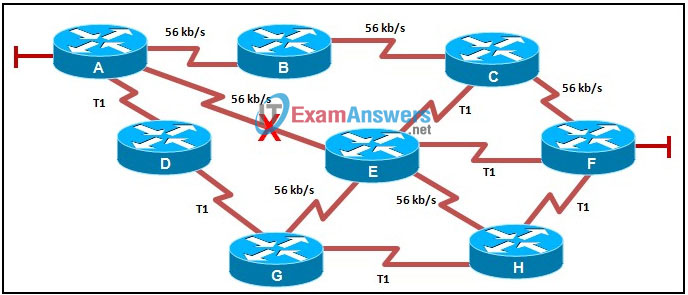
- A, B, C, F
- A, B, C, E, F
- A, D, G, H, F
- A, D, G, E, F
- A, D, G, E, H, F
35. A network administrator is setting up a new router with a device name of Admin, an encrypted password of cangetin, and the IP address 192.168.1.22/29 assigned to the first FastEthernet interface. Which command sequence correctly configures this router?
- Router(config)# hostname Admin
Admin(config)# enable secret cangetin
Admin(config)# interface fa0/1
Admin(config-if)#ip address 192.168.1.22 255.255.255.248 - Router(config)# hostname Admin
Admin(config)# enable password cangetin
Admin(config)# interface fa0/1
Admin(config-if)# ip address 192.168.1.22 255.255.255.248 - Router(config)# hostname Admin
Admin(config)# enable secret cangetin
Admin(config)# interface fa0/0
Admin(config-if)# ip address 192.168.1.22 255.255.255.248 - Router(config)# hostname Admin
Admin(config)# enable password cangetin
Admin(config)# interface fa0/0
Admin(config-if)# ip address 192.168.1.22 255.255.255.248
36. Which two locations can be the source of the Cisco IOS that is used by a router during the bootup process? (Choose two.)
- flash memory
- RAM
- NVRAM
- TFTP server
- configuration register
37. Refer to the exhibit. Which combination of IP address and subnet mask can be used on the serial interface of Router2 in order to put the interface in the same network as the serial interface of Router1?

- IP 172.16.0.18, subnet mask 255.255.255.0
- IP 172.16.32.15, subnet mask 255.255.255.240
- IP 172.16.0.18, subnet mask 255.255.255.252
- IP 172.16.32.18, subnet mask 255.255.255.252
38. Refer to the exhibit. A network engineer removes a new router from the shipping container and powers on the router to ensure it passes POST. Which port would the engineer use to perform the initial configuration?
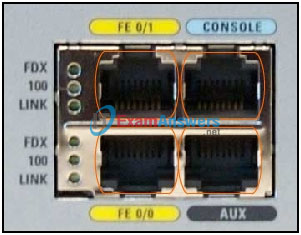
- AUX
- console
- FE0/0
- FE0/1
39. Which statement correctly describes a feature of RIP?
- RIP is a link-state routing protocol.
- RIP uses only one metric—hop count— for path selection.
- Advertised routes with hop counts greater than 10 are unreachable.
- Messages are broadcast every 10 seconds
40. Refer to the exhibit. Which two statements are true based on the exhibited output? (Choose two.)
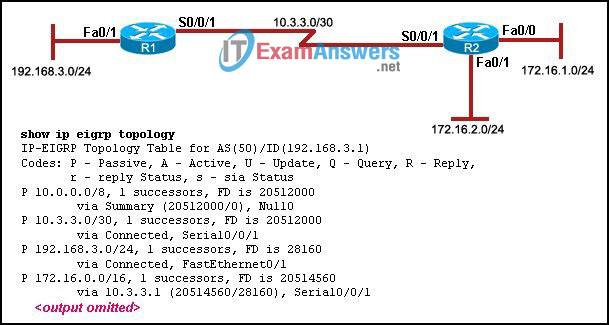
- All routes are stable.
- Each route has one feasible successor.
- The serial interface between the two routers is down.
- The administrative distance of EIGRP has been set to 50.
- The show ip eigrp topology command has been run on R1.
41. Refer to the exhibit. Which two statements are true based on the exhibited output? (Choose two.)
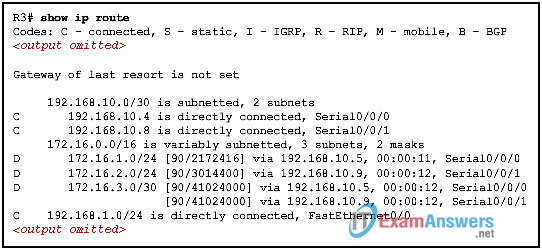
- Automatic summarization is disabled.
- The EIGRP routing protocol is being used.
- There is one feasible successor in the routing table.
- The serial interface S0/0/0 is administratively down.
- The router created the route to 172.16.1.0/24 via the S0/0/0 interface.
42. Refer to the exhibit. A network administrator wants to reduce the size of the routing table of R1. Which partial routing table entry in R1 represents the route summary for R2, without including any additional subnets?
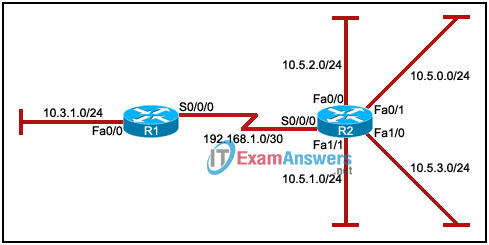
- 10.0.0.0/16 is subnetted, 1 subnets
D 10.5.0.0[90/205891] via 192.168.1.2, S0/0/0 - 10.0.0.0/24 is subnetted, 4 subnets
D 10.5.0.0[90/205198] via 192.168.1.2, S0/0/0 - 10.0.0.0/22 is subnetted, 1 subnets
D 10.5.0.0[90/205901] via 192.168.1.2, S0/0/0 - 10.0.0.0/8 is subnetted, 4 subnets
D 10.5.0.0[90/205001] via 192.168.1.2, S0/0/0
43. A network administrator is analyzing routing update behavior on a network that has both EIGRP and OSPF configured on all routers. Both protocols appear in the output of show ip protocols. However, only EIGRP internal routes appear in the routing tables. Which statement correctly explains the scenario?
- The OSPF protocol has a higher cost than EIGRP.
- The EIGRP protocol has a lower metric than OSPF.
- The EIGRP protocol was configured first on the router.
- The EIGRP protocol has a lower administrative distance than OSPF
44. Which prompt is used to allow a user to change the IP address of an interface on a router?
- Router>
- Router#
- Router(config)#
- Router(config-if)#
45. Refer to the exhibit. Routers RTRA and RTRB are running OSPF. What entry does RTRA add in the routing table when Serial 0/0/0 receives an update about the network that is attached to RTRB?

- O 172.16.7.0/30 [110/51] via 10.10.10.2, 00:00:25, Serial0/0/0
- O 172.16.7.16/28 [110/51] via 10.10.10.2, 00:00:25, Serial0/0/0
- O 172.16.7.0/24 [110/51] via 10.10.10.2, 00:00:25, Serial0/0/0
- O 172.16.0.0/16 [110/51] via 10.10.10.2, 00:00:25, Serial0/0/0
46. Which additional piece of information is included in the updates of classless routing protocols to support the use of VLSM and discontiguous networks?
- metric
- network mask
- neighbor router ID
- administrative distance
47. Because of a topology change, the next hop IP address in the current static route must be reconfigured. How can a static route entry be altered to accommodate a topology change?
- Keep the existing static route and configure a new static route with the correct next hop IP address.
- Negate the existing static route and configure a new static route with the correct next hop IP address.
- Do nothing. The existing static route will automatically update the next hop entry with the new IP address.
- Keep the existing static route, reload the router, and configure a new static route with the correct next hop IP address
48. A network administrator must use the subnet 172.16.128.0/18 to create 6 additional subnets each containing up to 2000 hosts for local LANs. Which subnet mask should the administrator use to create the new subnets?
- 255.255.224.0
- 255.255.240.0
- 255.255.248.0
- 255.255.252.0
49. Which router mode is accessed by entering the enable command?
- user EXEC
- privileged EXEC
- global configuration
- interface configuration
50. Refer to the exhibit. An administrator is attempting to configure a router by copying and pasting the commands that are shown in the exhibit. However, only one of the FastEthernet interfaces is coming up. What is the problem?
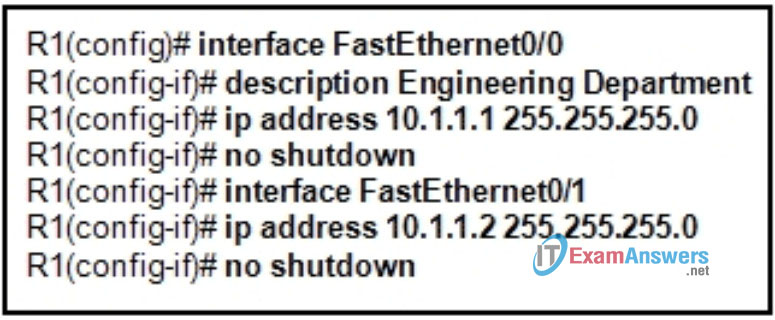
- Both interfaces are in the same IP subnet.
- FastEthernet0/1 does not have a description.
- There can be only one FastEthernet interface enabled on a router at one time.
- The administrator did not exit to global configuration mode before configuring FastEthernet0/1
51. In an examination of two OSPF routers that fail to exchange information, it is determined that they have not become OSPF neighbors. Which two configuration values must match for the OSPF routers to become neighbors?
- neighbor ID and router ID
- dead time and hello time
- OSPF area and neighbor ID
- OSPF area and interface priority
52. Refer to the exhibit. Routers R1 and R3 use different routing protocols with default administrative distance values. All devices are properly configured and the destination network is advertised by both protocols. Which path will be used to transmit the data packets from PC1 to PC2?

- The packets will travel via R2-R1.
- The packets will travel via R2-R3.
- The traffic will be load-balanced between two paths — via R2-R1 and via R2-R3.
- The packets will travel via R2-R3, and the other path via R2-R1 will be retained as the backup path
53. Why is fast convergence desirable in networks that use dynamic routing protocols?
- Hosts are unable to access their gateway until the network is converged.
- Routers will not allow packets to be forwarded until the network is converged.
- Routers may make incorrect forwarding decisions until the network has converged.
- Routers will not allow configuration changes to be made until the network has converged
54. Refer to the exhibit. Which solution provides the most efficient use of router resources for forwarding traffic between BR and HQ?

- RIP
- RIPv2
- EIGRP
- static routes
55. When connecting two devices, which situation would normally require the use of a crossover cable?
- connecting a host to a switch
- connecting a switch to a router
- connecting a switch to a switch
- connecting a host to a router console port
56. Refer to the exhibit. A network administrator is investigating why data packets with destination addresses of 172.16.10.10 and 192.168.10.100 are being dropped instead of being forwarded via the static route as expected. After confirming that the ip classless command has been applied on all routers in the network, what other action should the administrator take to ensure that data packets to these addresses are forwarded via the static route?
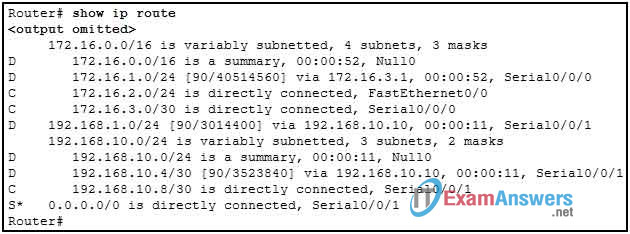
- Check that all routers are configured with the same autonomous system number.
- Issue the no auto-summary command within the EIGRP configuration of all routers.
- Issue the no passive-interface command within the EIGRP configuration of all routers.
- Configure the static route to point to the next hop address instead of the outbound interface.
57. Refer to the exhibit. The network is configured with RIPv2. However, network administrators notice that communication cannot be successfully completed from one LAN to another. A network administrator issues the show ip route command on the HQ router. Based on the output, what should be done to correct the problem?
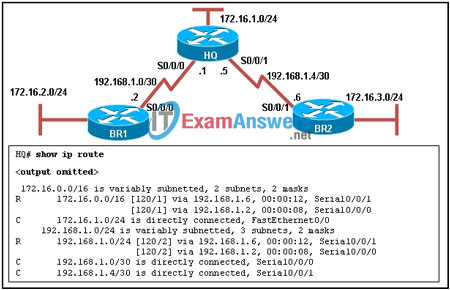
- Disable the load balancing feature of RIPv2.
- Issue the no auto-summary command for RIPv2.
- Replace RIPv2 with EIGRP which supports VLSM.
- Make sure that the network statements include the correct subnet mask
58. A network administrator configures a new router and saves the configuration. The router is taken to the installation site and installed. On startup, what component will the router search first by default for the saved configuration?
- CompactFlash
- CPU
- boot ROM
- flash
- NVRAM
- UART
59. Refer to the exhibit. What OSPF network statements are required for the router B to advertise the three networks that are attached?
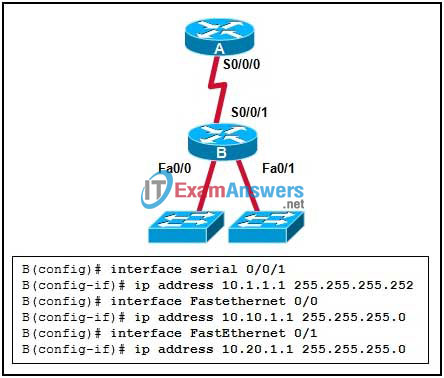
- router ospf 1 network 10.0.0.0 0.0.0.255 area 0
- router ospf 1 network 10.1.1.0 0.3.255.255 area 0 network 10.10.1.0 0.255.255.255 area 0 network 10.20.1.0 0.255.255.255 area 0
- router ospf 1 network 10.1.1.0 0.0.0.3 area 0 network 10.10.1.0 0.0.255.255 area 0 network 10.20.1.0 0.0.255.255 area 0
- router ospf 1 network 10.1.1.0 0.0.0.3 area 0 network 10.10.1.0 0.0.0.255 area 0 network 10.20.1.0 0.0.0.255 area 0
60. Refer to the exhibit. Why is the state of the serial0/0/0 interface administratively down?

- An IP address has not been configured on the interface.
- The WIC was installed into the incorrect slot on the router.
- The default encapsulation on the interface has been modified.
- The no shutdown command has not been executed on the interface
61. On a router, which three components are stored in RAM? (Choose three.)
- POST code
- the routing table
- the running-configuration
- the start-up configuration
- the bootstrap instructions
- a copy of the operating system
62. Refer to the exhibit. What is the purpose of the ip bandwidth-percent eigrp 50 10 command?

- to limit the bandwidth EIGRP packets can use to 6.4 kb/s
- to limit the bandwidth EIGRP packets can use to 10 kb/s
- to limit the bandwidth EIGRP packets can use to 32 kb/s
- to limit the bandwidth EIGRP packets can use to 50 kb/s
63. A network administrator adds the default-information originate command to the configuration of a router that uses RIP as the routing protocol. What will result from adding this command?
- The router will be reset to the default factory information.
- The router will not forward routing information that is learned from other routers.
- The router will propagate a static default route in its RIP updates, if one is present.
- The router will only forward packets that originate on directly connected networks
64. A network technician is configuring a Cisco 2811 router. The technician types conf at the privileged level command prompt and presses the TAB key. What action will the router take?
- It will revert to the user mode.
- It will perform an auto-complete function.
- It will go into the global configuration mode.
- It will give an error message that indicates a bad command was entered
65. What is a function of the console port on a router?
- It is used to manage the router.
- It is used for packet receiving and forwarding.
- It is used to interconnect various types of LANs.
- It is used to interconnect a variety of serial links including T1, DSL, and ISDN
66. Refer to the exhibit. Which route will be installed in the routing table on R1 to forward traffic from PC1 to the web server?
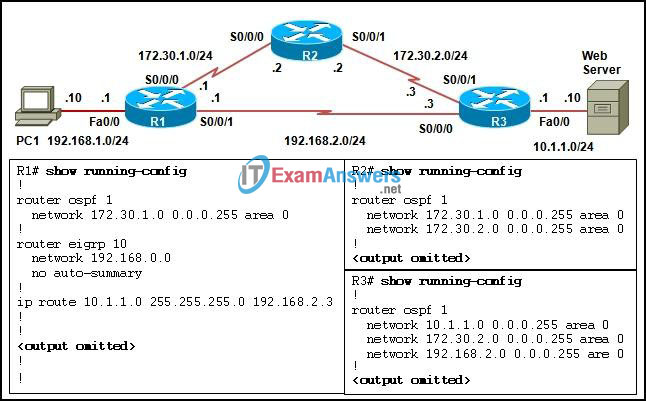
- the static route
- the route learned via OSPF
- the route learned via EIGRP
- both routes learned via OSPF and EIGRP
67. Refer to the exhibit. After the commands are entered, which password will be required to establish a Telnet session with the router?
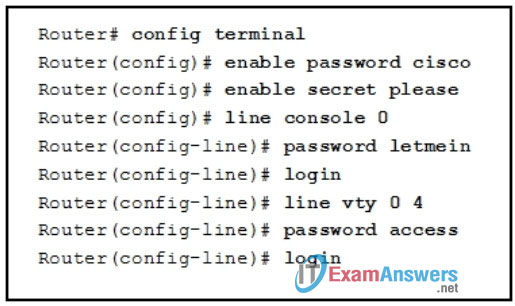
- cisco
- letmein
- please
- access
68. Refer to the exhibit. What information can be determined from the displayed output?

- EIGRP packets are waiting to be sent to the neighbors.
- The adjacencies between the routers are yet to be established.
- The IP address 192.168.10.10 is configured at serial interface S0/0/1 of router R2.
- Router R2 is receiving hello packets from a neighbor with the IP address 192.168.10.10 via the R2 S0/0/1 interface.
69. Which two router component and operation pair are correctly described? (Choose two.)
- DRAM – loads the bootstrap
- RAM – stores the operating system
- Flash – executes diagnostics at bootup
- NVRAM – stores the configuration file
- ROM – stores the backup configuration file
- POST – runs diagnostics on hardware modules
70. Refer to the exhibit. RouterA and RouterB cannot successfully exchange EIGRP routes. What is the problem?
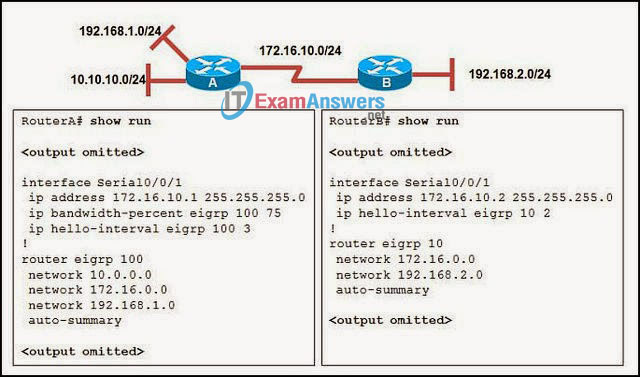
- The hello intervals do not match.
- The autonomous system numbers do not match.
- The no auto-summary command is missing from both routers.
- The ip bandwidth-percent command is missing from RouterB.
71. Refer to the exhibit. Which option will provide the configuration that is needed for router R1 to dynamically learn routes to the 192.168.100.16/28, 192.168.100.32/28, and 192.168.100.48/28 subnetworks?
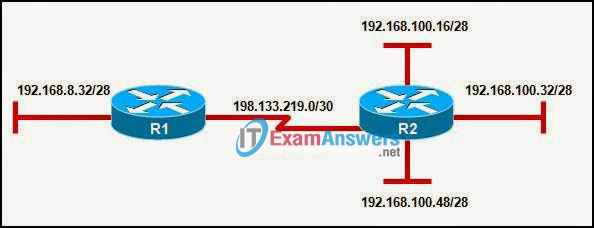
- with static routes
- with a routed protocol
- with a routing protocol
- with directly connected routes
72. Refer to the exhibit. The network administrator has run the following command on R1.
R1(config)# ip route 192.168.2.0 255.255.255.0 172.16.1.2

What is the result of running this command?
- Traffic for network 192.168.2.0 is forwarded to 172.16.1.2.
- This route is automatically propagated throughout the entire network.
- Traffic for all networks is forwarded to 172.16.1.2.
- The command invokes a dynamic routing protocol for 192.168.2.0.
73. A network administrator is using an application that is monitoring packets on the network and sees an EIGRP update packet. What is the purpose of the update packet?
- The packet is sent to discover neighbors within the EIGRP network.
- The packet is sent to search for network devices within an EIGRP network.
- The packet is used to propagate routing information within the EIGRP network.
- The packet is used to send an unreachable reply to another router within the EIGRP network.
- The packet is used to notify all routers that EIRGP has failed on one of the routers within the EIGRP network.
74. Which two statements are true about the router ID in a single area OSPF network? (Choose two.)
- Only the DR and BDR have a router ID.
- A loopback interface is required to configure the router ID.
- The router ID is used to uniquely identify each router in the OSPF routing domain.
- Any interface, even one not participating in the OSPF routing process, can be used to determine the router ID.
- If no loopback interfaces are configured, the router chooses the highest active IP address of any of its physical interfaces.
75. Refer to the exhibit. A network administrator has configured OSPF using the following command:
network 192.168.1.32 0.0.0.31 area 0

Which router interface will participate in OSPF?
- FastEthernet0/0
- FastEthernet0/1
- Serial0/0/0
- Serial0/0/1
76. Which two statements are true for link-state routing protocols? (Choose two.)
- Routers that run a link-state protocol can establish a complete topology of the network.
- Routers in a multipoint network that run a link-state protocol can exchange routing tables.
- Routers use only hop count for routing decisions.
- The shortest path first algorithm is used.
- Split horizon is used to avoid routing loops.
77. What is the function of the OSPF LSU packet?
- used to confirm receipt of certain types of OSPF packets
- used to establish and maintain adjacency with other OSPF routers
- used to request more information about any entry in the BDR
- used to announce new OSPF information and to reply to certain types of requests
78. Which two statements about routing protocols are accurate? (Choose two.)
- OSPF supports VLSM.
- RIPv1 supports VLSM.
- RIPv2 does not have a hop count limit.
- EIGRP supports discontiguous network designs.
- RIPv2 does not support discontiguous network designs.
79. Refer to the exhibit. Router R2 is configured properly and all interfaces are functional. Router R1 has been installed recently. Host A is unable to ping host B. Which procedure can resolve this problem?
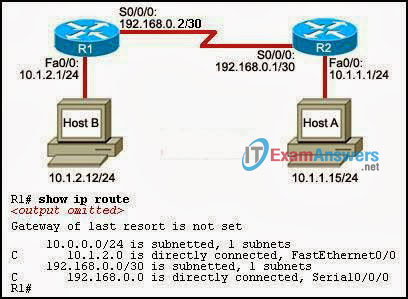
- Configure a static route on R1 using the IP address of the serial interface on R1.
- Configure a default route on R1 with the exit interface Fa0/0 on R1.
- Configure a static route on R1 using the IP address of S0/0/0 on R2.
- Configure a default route on R1 using the IP address of Fa0/0 on R2.
80. Refer to the exhibit. The interfaces of all routers are configured for OSPF area 0. R3 can ping R1, but the two routers are unable to establish a neighbor adjacency. What should the network administrator do to troubleshoot this problem?

- Check if the interfaces of the routers are enabled.
- Check the hello and dead intervals between the routers.
- Check the process ID of both routers.
- Check if CDP is enabled on all the routers.
81. Refer to the exhibit. The hosts on the R1 LAN are unable to access the Internet. What is incorrectly configured?

- the IP address of the Fa0/0 interface at R1
- the IP address of the S0/0/1 interface at R2
- the IP address of the S0/0/0 interface at R1
- the subnet mask of the S0/0/1 interface at R2
82. Refer to the exhibit. Which summarization should R1 use to advertise its networks to R2?
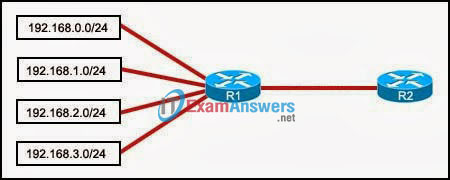
- 192.168.1.0/24
- 192.168.0.0/24
- 192.168.0.0/22
- 192.168.1.0/22
83. Which protocol is used by EIGRP to deliver and receive update packets?
- FTP
- RTP
- TCP
- TFTP
- UDP
84. Refer to the exhibit. If the EIGRP routing protocol is used throughout the network, which IP address and mask prefix should be sent by router R1 to the Edge router as a result of manual summarization of LANs A, B, C, and D?
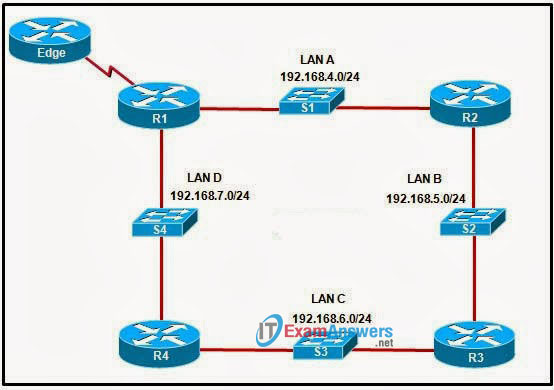
- 192.168.4.0/20
- 192.168.4.0/22
- 192.168.4.0/24
- 192.168.4.0/26
85. A technician needs to determine the value of the router ID for a branch router. What three commands can be used from the branch router to determine the router ID for a particular router that is participating in OSPF routing? (Choose three.)
- show ip ospf
- show ip route
- show ip protocols
- show ip ospf interface
- show ip ospf neighbor
- show ip interface brief
86. Refer to the exhibit. R1 and R2 are adjacent routers both running RIP. All interfaces on both routers are correctly configured and operational. Both routers are configured to include all connected interfaces in routing updates. R2 is not showing any routes from R1 in the routing table. What is the likely cause?
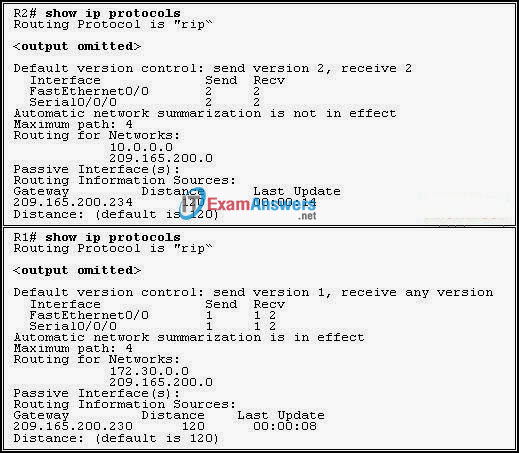
- The adjacent interfaces are passive.
- The distance of 120 exceeds 15 hops.
- R2 will not accept version 1 updates from R1.
- Routes are being summarized by R1 but not by R2.
87. Which multicast address does EIGRP use to send hello and updates packets?
- 224.0.0.5
- 224.0.0.6
- 224.0.0.9
- 224.0.0.10
88. Which default EIGRP configuration must be modified to allow an EIGRP router to advertise subnets that are configured with VLSM?
- split horizon
- metric K values
- autosummarization
- hello and dead intervals
89. Refer to the exhibit. A technician has configured the interfaces on the Router, but upon inspection discovers that interface FastEthernet0/1 is not functioning. Which action will most likely correct the problem with FastEthernet0/1?

- A clock rate should be added to the interface configuration.
- The subnet mask should be added to the interface configuration.
- An interface description needs to be added to the interface configuration.
- The no shutdown command needs to be added to the interface configuration.
90. Refer to the exhibit. Routers R1 and R2 are directly connected through a FastEthernet link but cannot form a neighbor adjacency. What could resolve the problem?
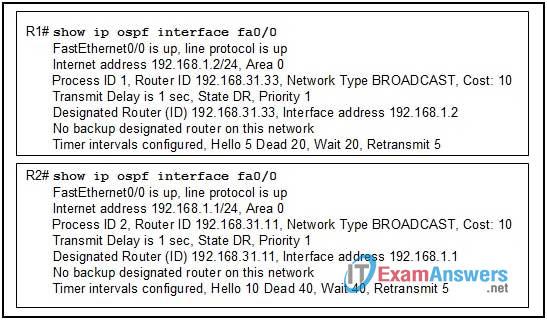
- The cost on R1 should be set higher.
- The priority on R1 should be set higher.
- The OSPF process ID numbers must match.
- A backup designated router needs to be added to the network.
- The hello and dead timers must be configured with the same values on both routers.
91. Refer to the exhibit. Host A is having problems accessing server A. All routers have the same EIGRP configuration as router RTR_A. What should be done so that host A can access server A?
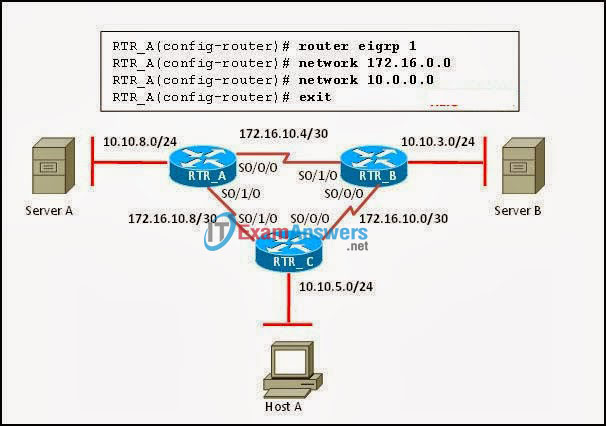
- Add the command no auto-summary on all routers.
- Change the network statements to include a wildcard mask.
- Adjust the EIGRP hello timers to account for the network delay.
- Add the command eigrp log-neighbor-changes on all routers.
92. Refer to the exhibit. All routers are configured to use the EIGRP routing protocol with default settings, all routes are advertised on all routers, and the network is fully converged. Which path will the data take to travel between 172.16.1.0/24 and 192.168.100.0/24?
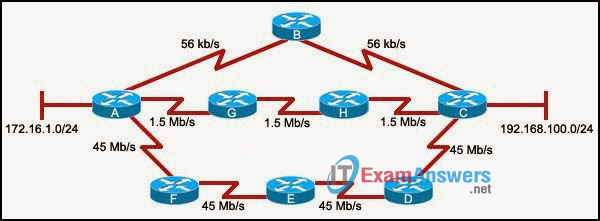
- It will travel via A, B, and C.
- It will travel via A, F, E, D, and C.
- It will travel via A, G, H, and C.
- The traffic will be load-balanced on all paths.
93. Which of the following are primary functions of a router? (Choose two.)
- packet switching
- microsegmentation
- domain name resolution
- path selection
- flow control
94. In a complex lab test environment, a router has discovered four paths to 192.168.1.0/24 via the use of the RIP routing process. Which route will be installed in the routing table after the discovery of all four paths?
- R 192.168.1.0/24 [120/3] via 192.168.110.1, 00:00:17, Serial0/1/0
- R 192.168.1.0/24 [120/2] via 192.168.200.1, 00:00:17, Serial0/0/0
- R 192.168.1.0/24 [120/1] via 192.168.100.1, 00:00:17, Serial0/0/1
- R 192.168.1.0/24 [120/4] via 192.168.101.1, 00:00:17, Serial0/1/1
95. Refer to the exhibit. Router R1 receives a packet with a destination of 172.19.130.1. To which network in the routing table will the packet be matched?
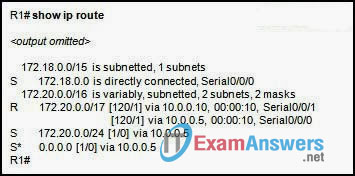
- 172.20.0.0/16
- 172.20.0.0/17
- 172.20.0.0/24
- 172.18.0.0/15
- 0.0.0.0/0
96. Refer to the exhibit. Which path will traffic from the 172.16.1.0/24 network take to get to the 10.0.0.0/24 network?
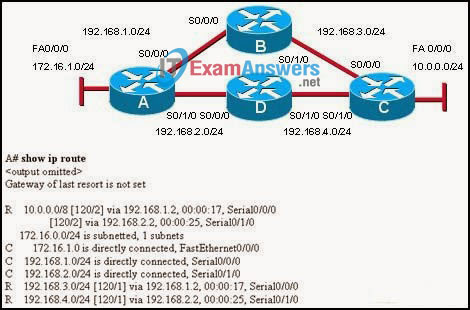
- ADC
- ABC
- It will load balance the traffic between ADC and ABC
- It will send the traffic via ABC, and will use ADC as a backup path only when ABC fails.
97. Refer to the exhibit. Host A is unable to access the Internet. What is the reason for this?
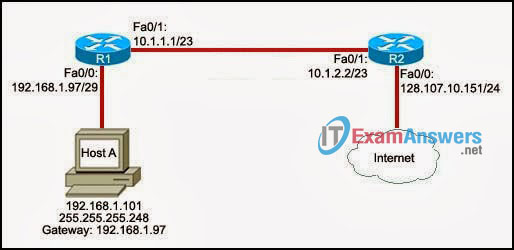
- The IP address of host A is incorrect.
- The default gateway of host A is incorrect.
- The Fa0/1 interfaces of the two routers are configured for different subnets.
- The subnet mask for the Fa0/0 interface of R1 is incorrect.
98. Refer to the exhibit. R1 and R2 are both configured with RIPv1. Beginning from global configuration mode, what comand or commands will eliminate RIP updates on the Ethernet segment of R2?
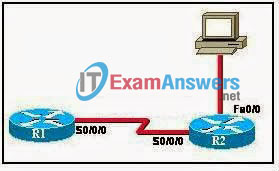
- R2# configure terminal
R2(config)# router rip
R2(config-router)# passive-interface FastEthernet0/0 - R2# configure terminal
R2(config)# passive-interface FastEthernet0/0 - R2# passive-interface FastEthernet0/0
- R2# configure terminal
R2(config)# interface FastEthernet0/0
R2(config-if)# passive-interface FastEthernet0/0
99. What is a characteristic of classful routing?
- support for VLSM
- the use of 48-bit addresses
- routing updates do not include a subnet mask
- addresses that are typically entered in hexadecimal format
100. Refer to the exhibit. The 10.4.0.0 network fails. What mechanism prevents R2 from receiving false update information regarding the 10.4.0.0 network?

- split horizon
- hold-down timers
- route poisoning
- triggered updates
101. Refer to the exhibit. Which IP address and subnet mask can be configured on host H1 if it is to communicate with the network?
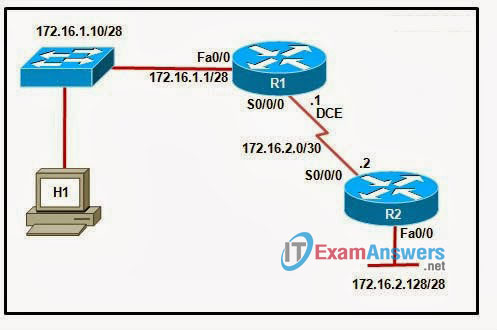
- 172.16.1.0 255.255.255.248
- 172.16.1.14 255.255.255.240
- 172.16.1.17 255.255.255.240
- 172.16.2.1 255.255.240.0
- 172.16.2.2 255.255.255.0
102. Refer to the exhibit. What will happen when the router reloads?
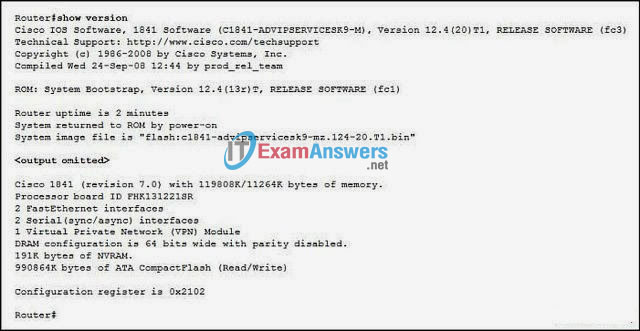
- It will boot into ROMMON mode.
- It will ignore the start-up configuration file.
- It will look for the start-up configuration file on the TFTP server.
- It will attempt to load the start-up configuration file that is stored in NVRAM.
103. A router has learned about a network through static and dynamic routing processes. Which route will be used to reach network 192.168.168.0?
- D 192.168.168.0/24 [90/2195456] via 192.168.200.1, 00:00:09, Ethernet0
- O 192.168.168.0/24 [110/1012] via 192.168.200.1, 00:00:22, Ethernet0
- R 192.168.168.0/24 [120/1] via 192.168.200.1, 00:00:17, Ethernet0
- S 192.168.168.0/24 [1/0] via 192.168.200.1
104. Refer to the exhibit. The command ip route 0.0.0.0 0.0.0.0 S0/0/0 is run on router R2. What are the two results of this command? (Choose two.)

- A static route will be updated in the routing table.
- The traffic from the Internet will be directed to R2.
- The traffic from the source network 172.16.0.0/22 will be blocked.
- The route will be specified as the default route for all networks not defined in the routing table.
- All the broadcasts will be forwarded via the S0/0/0 interface of R2.
105. Refer to the exhibit. What does the state “FULL/ -” indicate?

- The DR/BDR election is currently taking place.
- The router with router ID 10.112.0.34 and RouterA are on a point-to-point network.
- RouterA could not form a neighbor relationship with the router with router ID 10.112.0.34.
- OSPF hello and dead timers between RouterA and the router with router ID 10.112.0.34 do not match.
106. You have been asked to explain converged networks to a trainee. How would you accurately describe a converged network?
- A network is converged when all routers have formed an adjacency.
- A network is converged immediately after a topology change has occurred.
- A network is converged when all routers flush the unreachable networks from their routing tables.
- A network is converged after all routers share the same information, calculate best paths, and update their routing tables.
107. Refer to the exhibit. Based on the partial output in the exhibit, why can users establish a console connection to this router without entering a password?
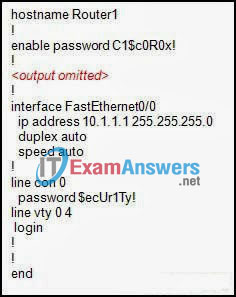
- The login command was not entered on the console line.
- The enable password should be an enable secret password.
- No username and password combination has been configured.
- Console connections cannot be configured to require users to provide passwords.
108. Refer to the exhibit. On the basis of the show running-config output, which option correctly reflects the routes that will be listed in the R2 routing table?
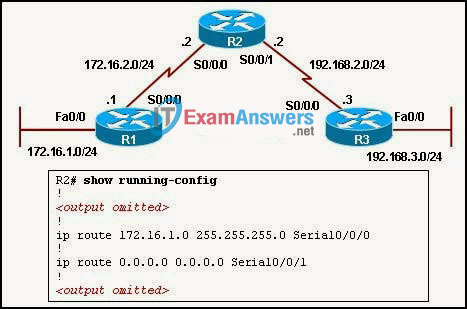
- C 172.16.0.0 is directly connected, Serial0/0/0
C 192.168.2.0 is directly connected, Serial0/0/1
S* 0.0.0.0 is directly connected, Serial0/0/0 - S 172.16.1.0 [1/0] via 172.16.2.1
C 172.16.2.0 is directly connected, Serial0/0/0
C 192.168.2.0 is directly connected, Serial0/0/1 - S 172.16.1.0 [1/0] via 172.16.2.1
C 172.16.2.0 is directly connected, Serial0/0/0
C 192.168.2.0 is directly connected, Serial0/0/1
S* 0.0.0.0 is directly connected, Serial0/0/1 - S 172.16.1.0 is directly connected, Serial0/0/0
C 172.16.2.0 is directly connected, Serial0/0/0
C 192.168.2.0 is directly connected, Serial0/0/1
S* 0.0.0.0 is directly connected, Serial0/0/1
109. Refer to the exhibit. A ping from R1 to 10.1.1.2 is successful, but a ping from R1 to 192.168.2.0 fails. What is the cause of this problem?
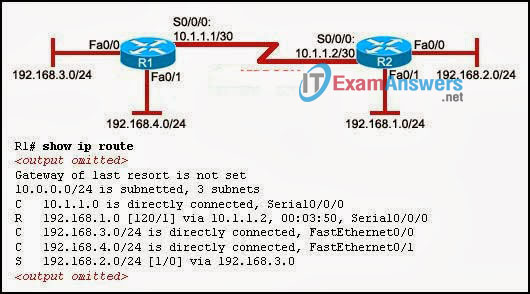
- There is no gateway of last resort at R1.
- The serial interface between the two routers is down.
- A default route is not configured on R1.
- The static route for 192.168.2.0 is incorrectly configured.
110. When would the IOS image held in ROM be used to boot the router?
- during a file transfer operation
- during a normal boot process
- when the full IOS cannot be found
- when the running configuration directs the router to do this
111. A router needs an IOS upgrade. Which component must be checked to make sure it meets the requirement for the new IOS?
- boot ROM
- Fast Ethernet ports
- flash
- serial ports
- UART
- CPU
112. Refer to the exhibit. Given the topology shown in the exhibit, what three commands are needed to configure EIGRP on the Paris router? (Choose three.)
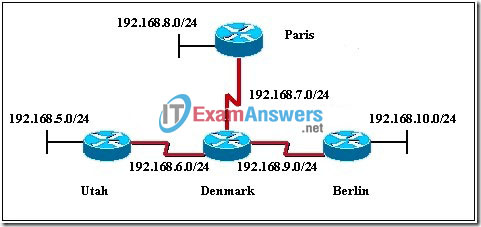
- Paris(config)# router eigrp 100
- Paris(config)# router eigrp
- Paris(config-router)# network 192.168.6.0
- Paris(config-router)# network 192.168.7.0
- Paris(config-router)# network 192.168.8.0
- Paris(config-router)# network 192.168.9.0
113. Refer to the exhibit. R1 and R2 are unable to establish an adjacency. What two configuration changes will correct the problem? (Choose two.)
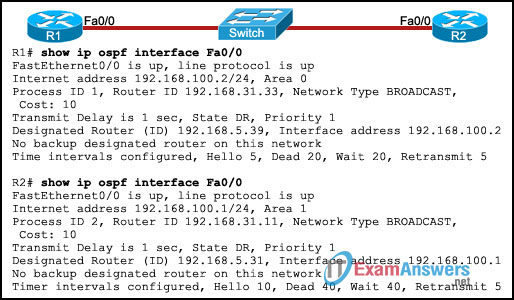
- Set a lower priority on R2.
- Configure the routers in the same area.
- Set a lower cost on R2 compared to R1.
- Add a backup designated router to the network.
- Match the hello and dead timers on both routers.
114. Refer to the exhibit. Although R2 is configured correctly, host A is unable to access the Internet. Which two static routes can be configured on R1 to enable Internet connectivity for host A? (Choose two.)
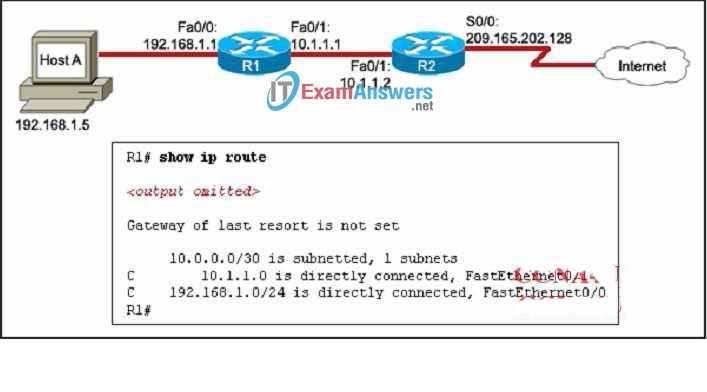
- ip route 0.0.0.0 0.0.0.0 Fa0/0
- ip route 0.0.0.0 0.0.0.0 Fa0/1
- ip route 0.0.0.0 0.0.0.0 10.1.1.1
- ip route 0.0.0.0 0.0.0.0 10.1.1.2
- ip route 209.165.202.0 255.255.255.0 10.1.1.1
- ip route 209.165.202.0 255.255.255.0 10.1.1.2
115. Refer to the exhibit. Two routers are unable to establish an adjacency. What is the possible cause for this?
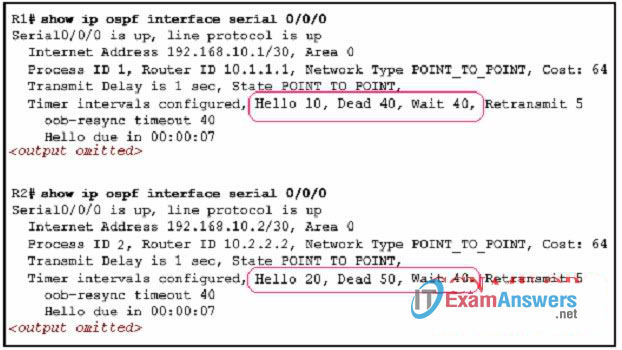
- The two routers are connected on a multiaccess network.
- The hello and dead intervals are different on the two routers.
- They have different OSPF router IDs.
- They have different process IDs.
116. Refer to the exhibit. R1 knows two routes, Path A and Path B, to the Ethernet network attached to R3. R1 learned Path A to network 10.2.0.0/16 from a static route and Path B to network 10.2.0.0/16 from EIGRP. Which route will R1 install in its routing table?
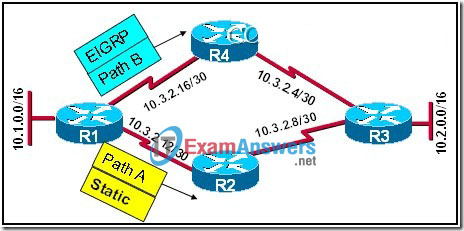
- Both routes are installed and load balancing occurs across both paths.
- The route via Path B is installed because the EIGRP route has the best metric to network 10.2.0.0/16.
- The route via Path A is installed because the static route has the best metric to network 10.2.0.0/16.
- The route via Path B is installed because the EIGRP route has the lowest administrative distance to network 10.2.0.0/16.
- The route via Path A is installed because the static route has the lowest administrative distance to network 10.2.0.0/16.
117. Refer to the exhibit. A ping between the serial interfaces of R1 and R2 is successful, but a ping between their FastEthernet interfaces fails. What is the reason for this problem?
- The FastEthernet interface of R1 is disabled.
- One of the default routes is configured incorrectly.
- A routing protocol is not configured on both routers.
- The default gateway has not been configured on both routers.
118. Which router component is used to store the routing table?
- Flash
- NVRAM
- ROM
- SDRAM
119. What two routing protocols use a hierarchal network topology? (Choose two.)
- IS-IS
- EIGRP
- OSPF
- RIPv1
- RIPv2
120. Refer to the exhibit. Routers R1 and R2 are directly connected via their serial interfaces and are both running the EIGRP routing protocol. R1 and R2 can ping the directly connected serial interface of their neighbor, but they cannot form an EIGRP neighbor adjacency. What action should be taken to solve this problem?
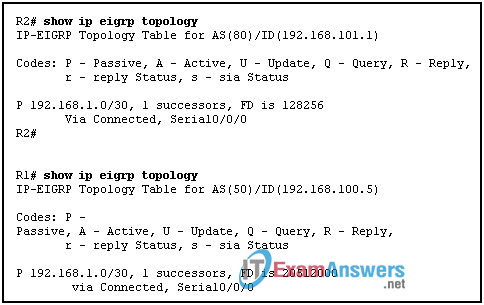
- Enable the serial interfaces of both routers.
- Configure EIGRP to send periodic updates.
- Configure the same hello interval between the routers.
- Configure both routers with the same EIGRP process ID.
121. Refer to the exhibit. What information can be determined from the highlighted output?
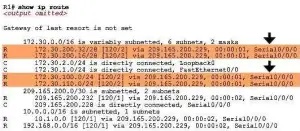
- R1 is originating the route 172.30.200.32/28.
- Automatic summarization is disabled.
- The 172.30.200.16/28 network is one hop away from R1.
- A classful routing protocol is being used.
122. Refer to the exhibit. All routers are running RIPv1. The two networks 10.1.1.0/29 and 10.1.1.16/29 are unable to access each other. What can be the cause of this problem?
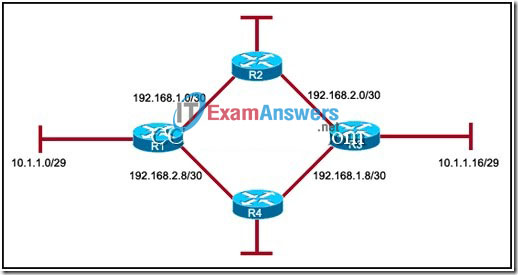
- Because RIPv1 is a classless protocol, it does not support this access.
- RIPv1 does not support discontiguous networks.
- RIPv1 does not support load balancing.
- RIPv1 does not support automatic summarization.
123. Refer to the exhibit. A network administrator has enabled RIP on routers B and C in the network diagram. Which of the following commands will prevent RIP updates from being sent to Router A?
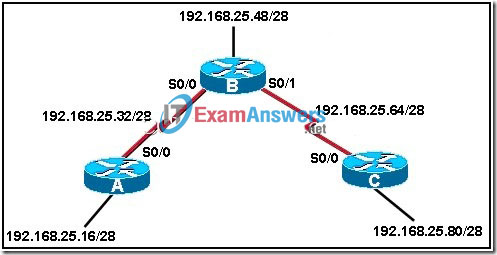
- A(config)# router rip
A(config-router)# passive-interface S0/0 - B(config)# router rip
B(config-router)# network 192.168.25.48
B(config-router)# network 192.168.25.64 - A(config)# router rip
A(config-router)# no network 192.168.25.32 - B(config)# router rip
B(config-router)# passive-interface S0/0 - A(config)# no router rip
124. Refer to the exhibit. A network administrator has configured R1 as shown, and all interfaces are functioning correctly. A ping from R1 to 172.16.1.1 fails. What could be the cause of this problem?
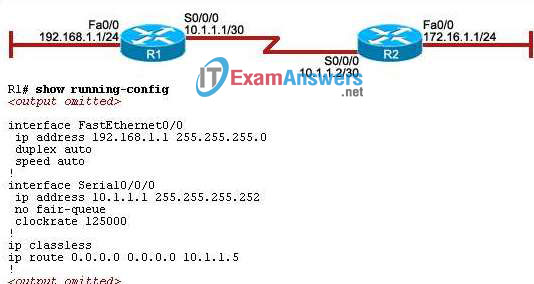
[SCM]actwin,0,0,0,0;http://
assessment.netacad.net/virtuoso/delivery/pub-doc/exam.shtml – Google Chrome
chrome
04.03.2013 , 23:32:58
- The serial interface on R1 is configured incorrectly.
- The default route is configured incorrectly.
- The default-information originate command must be issued on R1.
- Autosummarization must be disabled on R1.
125. Refer to the exhibit. What is the meaning of the highlighted value 2?

- It is the administrative distance of the routing protocol.
- It is the number of hops between R2 and the 192.168.8.0/24 network.
- It is the value used by the DUAL algorithm to determine the bandwidth for the link.
- It is the convergence time measured in seconds.
126. Refer to the exhibit. Based on the output from the show running-config and debug ip rip commands, what are two of the routes that are added to the routing table of R1? (Choose two.)
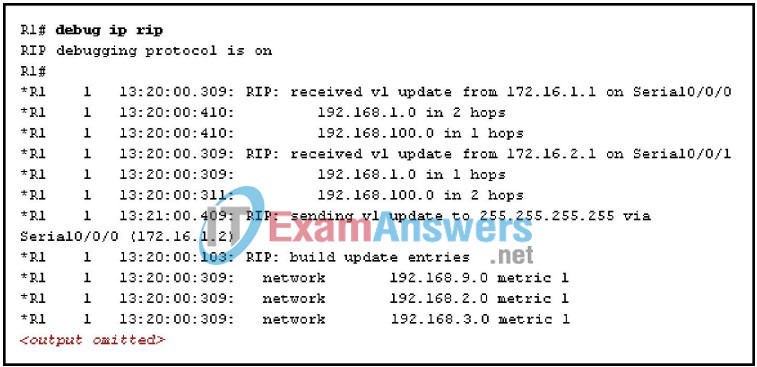
- R 192.168.1.0/24 [120/1] via 172.16.2.1, 00:00:24, Serial0/0/1
- R 192.168.100.0/24 [120/1] via 172.16.1.1, 00:00:24, Serial0/0/0
- S 192.168.1.0/24 [1/0] via FastEthernet0/0
- R 192.168.9.0/24 [120/1] via 172.16.2.1, 00:00:24, Serial0/0/0
- R 192.168.2.0/24 [120/1] via 172.16.1.2, 00:00:24, Serial0/0/0
127. What are two functions of a router? (Choose two.)
- It forwards data packets toward their destination.
- It forwards the packet to the destination if the TTL value is 0.
- It changes the destination IP address of data packets before forwarding them to an exit interface.
- It determines the best path based on the destination MAC address.
- It acts as an intersection between multiple IP networks.
128. Refer to the exhibit. The network has three connected routers: R1, R2, and R3. The routes of all three routers are displayed. All routers are operational and pings are not blocked on this network. Which ping will fail?
- from R1 to 172.16.1.1
- from R1 to 192.168.3.1
- from R2 to 192.168.1.1
- from R2 to 192.168.3.1
129. A network administrator needs to assign the very last usable IP address in the 172.24.64.0/18 network range to the router interface that serves this LAN. Which IP address should the administrator configure on the interface?
- 172.16.128.154/18
- 172.16.255.254/18
- 172.24.64.254/18
- 172.24.127.254/18
130. Refer to the exhibit. An administrator is adding a new subnet of 50 hosts to R3. Which subnet address should be used for the new subnet that provides enough addresses while wasting a minimum of addresses?
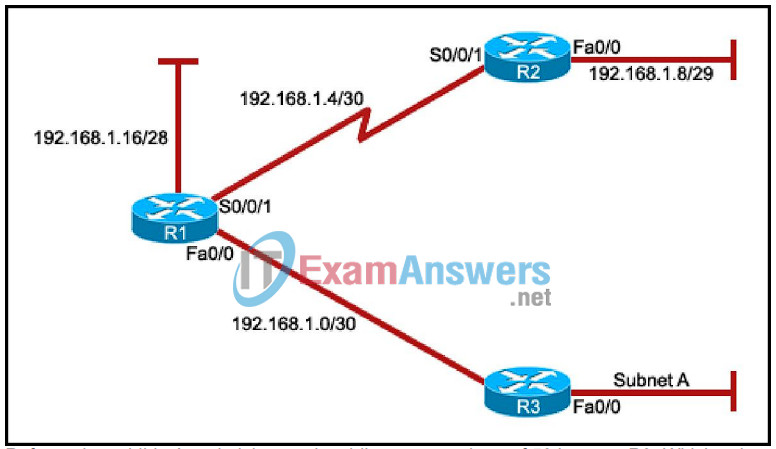
- 192.168.1.0/24
- 192.168.1.48 /28
- 192.168.1.32/27
- 192.168.1.64/26
131. Refer to the exhibit. Which statement is true concerning the routing configuration?
- Using dynamic routing instead of static routing would have required fewer configuration steps.
- The 10.1.1.0/24 and 10.1.2.0/24 routes have adjacent boundaries and should be summarized.
- Packets routed to the R2 Fast Ethernet interface require two routing table lookups.
- The static route will not work correctly.
- 30. Refer to the exhibit. Which statement is true about router R2?
- The routing table content indicates that interface S0/0/0 is administratively down.
- The route for 172.16.1.0 is a static route.
- A packet that is destined for a host on the 172.16.3.0 network is forwarded without performing a routing table lookup.
- The packets that are routed to network 172.16.1.0 require two routing table lookups.
132. What command would the network administrator apply to a router that is running OSPF to advertise the entire range of addresses included in 172.16.0.0/19 in area 0?
- R1(config-router)# network 172.16.0.0 0.0.0.255 area 0
- R1(config-router)# network 172.16.0.0 0.0.3.255 area 0
- R1(config-router)# network 172.16.0.0 0.0.15.255 area 0
- R1(config-router)# network 172.16.0.0 0.0.31.255 area 0
133. How does route poisoning prevent routing loops?
- New routing updates are ignored until the network has converged.
- Failed routes are advertised with a metric of infinity.
- A route is marked as unavailable when its Time to Live is exceeded.
- The unreachable route is cleared from the routing table after the invalid timer expires.
134. Refer to the exhibit. A router learns a route to the 192.168.6.0 network, as shown in the output of the show ip rip database command. However, upon running the show ip route command, the network administrator sees that the router has installed a different route to the 192.168.6.0 network learned via EIGRP. What could be the reason for the missing RIP route?
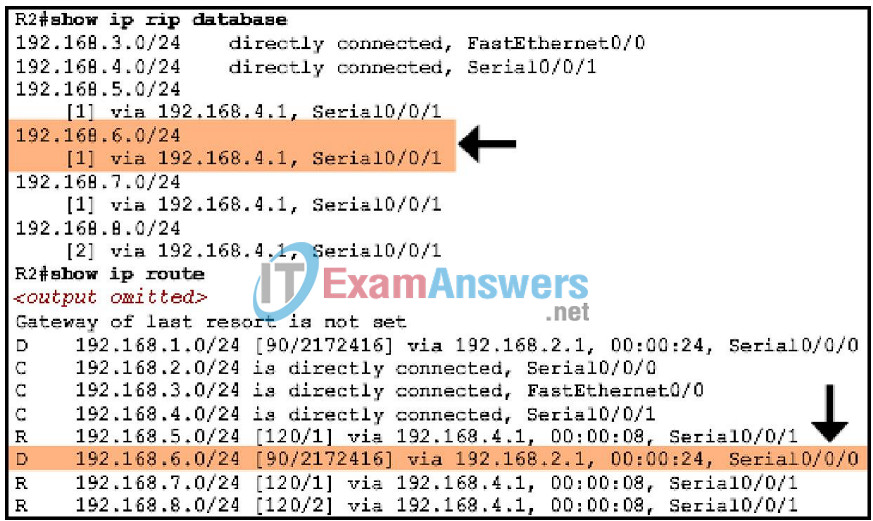
- Compared to RIP, EIGRP has a lower administrative distance.
- Compared to EIGRP, RIP has a higher metric value for the route.
- Compared to RIP, the EIGRP route has fewer hops.
- Compared to RIP, EIGRP has a faster update timer.
135. Refer to the exhibit. Packets destined to which two networks will require the router to perform a recursive lookup? (Choose two.)
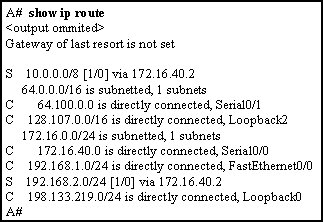
- 10.0.0.0/8
- 64.100.0.0/16
- 128.107.0.0/16
- 172.16.40.0/24
- 192.168.1.0/24
- 192.168.2.0/24
136. Which statement is true about the RIPv1 protocol?
- It is a link-state routing protocol.
- It excludes subnet information from the routing updates.
- It uses the DUAL algorithm to insert backup routes into the topology table.
- It uses classless routing as the default method on the router.
137. All routers in a network are configured in a single OSPF area with the same priority value. No loopback interface has been set on any of the routers. Which secondary value will the routers use to determine the router ID?
- The highest MAC address among the active interfaces of the network will be used.
- There will be no router ID until a loopback interface is configured.
- The highest IP address among the active FastEthernet interfaces that are running OSPF will be used.
- The highest IP address among the active interfaces will be used.
138. Which three statements describe the operation of routing with EIGRP? (Choose three.)
- As new neighbors are discovered, entries are placed in a neighbor table.
- If the feasible successor has a higher advertised cost than the current successor route, then it becomes the primary route.
- If hello packets are not received within the hold time, DUAL must recalculate the topology.
- The reported distance is the distance to a destination as advertised by a neighbor.
- EIGRP maintains full knowledge of the network topology in the topology table and exchanges full routing information with neighboring routers in every update.
- EIGRP builds one routing table that contains routes for all configured routed protocols.
139. Refer to the exhibit. The network administrator is planning IP addressing of a new network. What part of this addressing scheme must be changed to allow communication between host A and the server?
- the IP address of the server
- the default gateway of host A
- the IP address of host A
- the default gateway of the server
140. Which two statements are correct about the split horizon with poison reverse method of routing loop prevention? (Choose two.)
- It is enabled by default on all Cisco IOS implementations.
- It assigns a value that represents an infinite metric to the poisoned route.
- It sends back the poisoned route update to the same interface from where it was received.
- It instructs routers to hold all changes that might affect routes, for a specified period of time.
- It limits the number of hops a packet can traverse through the network before it is discarded.
141. What are two tasks that must be completed before two routers can use OSPF to form a neighbor adjacency? (Choose two.)
- The routers must elect a designated router.
- The routers must agree on the network type.
- The routers must use the same dead interval.
- The routers must exchange link state requests.
- The routers must exchange database description packets.
142. Which two components are used to determine the router ID in the configuration of the OSPF routing process? (Choose two.)
- the IP address of the first FastEthernet interface
- the highest IP address of any logical interface
- the highest IP address of any physical interface
- the default gateway IP address
- the priority value of 1 on any physical interface
143. What is the function of the OSPF LSR packet?
- It is used to confirm the receipt of LSUs.
- It is used to establish and maintain adjacency with other OSPF routers.
- It is used by the receiving routers to request more information about any entry in the DBD.
- It is used to check the database synchronization between routers.
144. Refer to the exhibit. Which router is advertising subnet 172.16.1.32/28?
- Router1
- Router2
- Router3
- Router4
145. Refer to the exhibit. All router interfaces are configured with an IP address and are operational. If no routing protocols or static routes are configured, what information will be included in the show ip route command output for router A?
- All of the 192.168.x.0 networks will be in the routing table.
- Routes to networks 192.168.1.0/24, 192.168.2.0/24, and 192.168.3.0/24 will be in the routing table.
- The routing table will be empty because routes and dynamic routes have not been configured.
- A default route is automatically installed in the routing table to allow connectivity between the networks.
146. When a router boots, what is the default order to locate the Cisco IOS if there is no boot system command?
- ROM, TFTP server, flash
- flash, TFTP server, ROM
- flash, NVRAM, TFTP server
- NVRAM, TFTP server, flash
147. Refer to the exhibit. While trying to diagnose a routing problem in the network, the network administrator runs the debug ip rip command. What can be determined from the output of this command?
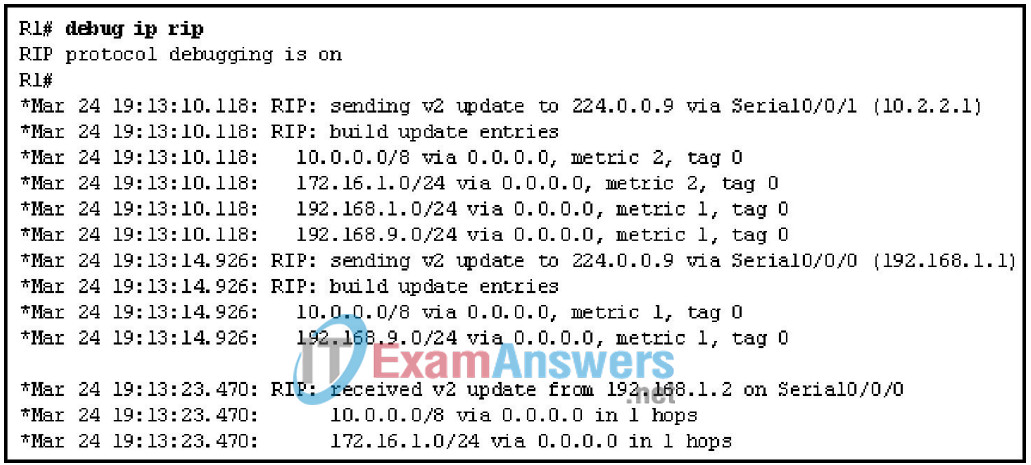
- The router will be unable to ping 192.168.1.2.
- The router has two interfaces that participate in the RIP process.
- The router will forward the updates for 192.168.1.0 on interface Serial0/0/1.
- The router is not originating routes for 172.16.1.0.
148. Refer to the exhibit. Which three statements are true of the routing table for Router1? (Choose three.)
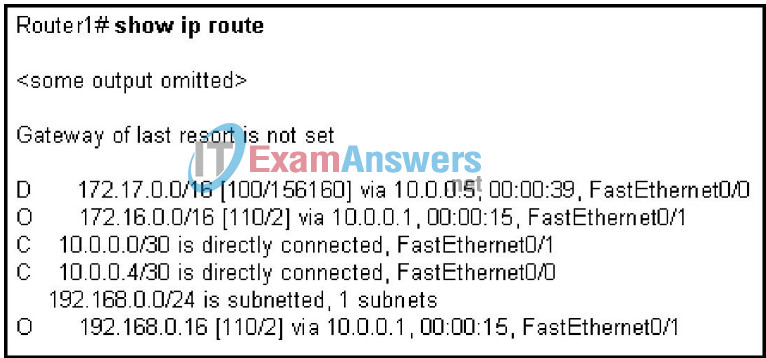
- The route to network 172.16.0.0 has an AD of 156160.
- Network 192.168.0.16 can best be reached using FastEthernet0/0.
- The AD of EIGRP routes has been manually changed to a value other than the default value.
- Router1 is running both the EIGRP and OSPF routing process.
- Network 172.17.0.0 can only be reached using a default route.
- No default route has been configured.
149. Which two statements are true regarding link-state routing protocols? (Choose two.)
- They are aware of the complete network topology.
- They offer rapid convergence times in large networks.
- They do not include subnet masks in their routing updates.
- They rely on decreasing hop counts to determine the best path.
- They do not work well in networks that require special hierarchical designs.
- They pass their entire routing tables to their directly connected neighbors only.
150. Refer to the exhibit. What action will R2 take for a packet that is destined for 192.168.2.0?
- It will drop the packet.
- It will forward the packet via the S0/0/0 interface.
- It will forward the packet via the Fa0/0 interface.
- It will forward the packet to R1.
151. Refer to the exhibit. Which two facts can be derived from this output? (Choose two.)
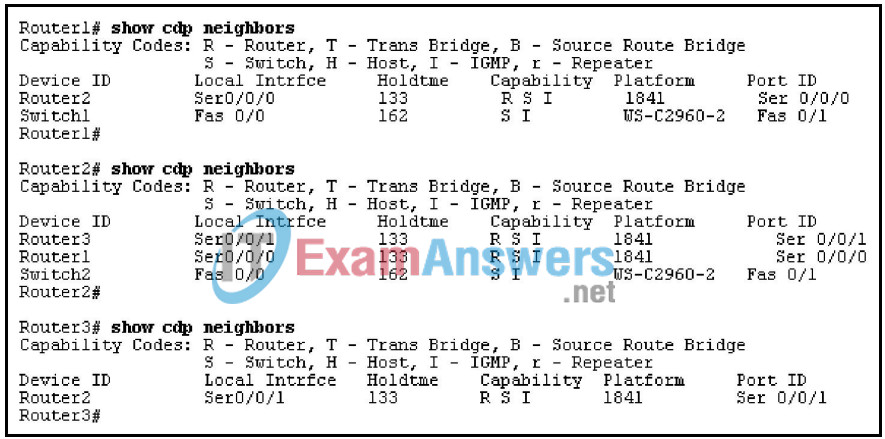
- Three network devices are directly connected to Router2.
- The serial interface between Router2 and Router3 is up.
- Router1 and Router3 are directly connected.
- Six devices are up and running on the network.
- Layer 3 functionality between routers is configured properly.
152. A network is configured with the IP, IPX, and AppleTalk protocols. Which routing protocol is recommended for this network?
- RIPv1
- RIPv2
- EIGRP
- OSPF
153. Refer to the exhibit. To implement the RIPv2 protocol, the network administrator runs the commands as displayed. However, the show ip protocol command fails to display any output. How can the administrator solve the problem that is indicated by the lack of output from this command?
- Include the default-information originate command.
- Include the no auto-summary command.
- Specify the network for which RIP routing has to be enabled.
- Implement RIPv2 authentication in the network.
154. Refer to the exhibit. The show cdp neighbors command was run at R1. Which two facts about the newly detected device can be determined from the output? (Choose two.)
- ABCD is a router that is connected to R1.
- ABCD is a non-CISCO device that is connected to R1.
- The device is connected at the Serial0/0/1 interface of R1.
- R1 is connected at the S0/0/1 interface of device ABCD.
- ABCD does not support switching capability.
155. Refer to the exhibit. The routers are properly configured using a dynamic routing protocol with default settings, and the network is fully converged. Router A is forwarding data to router E. Which statement is true about the routing path?
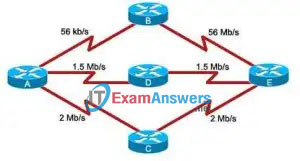
- If the network uses the RIP protocol, router A will determine that all paths have equal cost.
- If the network uses the RIP protocol, router A will update only the A-C-E path in its routing table.
- If the network uses the EIGRP routing protocol, router A will determine that path A-D-E has the lowest cost.
- If both RIP and EIGRP protocols are configured on router A, the router will use the route information that is learned by the RIP routing protocol.
156. Refer to the exhibit. All interfaces are addressed and functioning correctly. The network administrator runs the tracert command on host A. Which two facts could be responsible for the output of this command? (Choose two.)
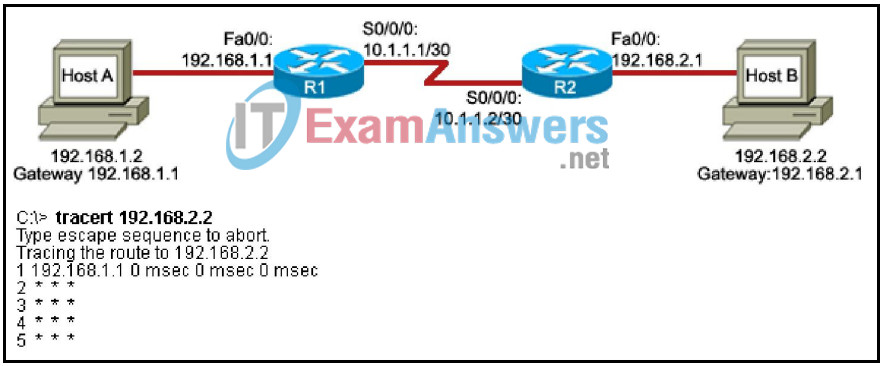
- The entry for 192.168.2.0/24 is missing from the routing table of R1.
- The entry for 192.168.1.0/24 is missing from the routing table of R2.
- The entry for 10.1.1.0/30 is missing from the routing table of R1.
- The entry for 10.1.1.0/30 is missing from the routing table of R2.
- The entry for 192.168.1.0/24 is missing from the routing table of R1.
- The entry for 192.168.2.0/24 is missing from the routing table of R2.
157. Refer to the exhibit. Both routers are using the RIP protocol. Devices on the 192.168.1.1 network can ping the S0/0/0 interface on R2 but cannot ping devices on the 192.168.2.1 network. What is a possible cause of this problem?
- The routers are configured with different versions of RIP.
- R2 is not forwarding the routing updates.
- The R1 configuration should include the no auto-summary command.
- The maximum path number has been exceeded.
158. Refer to the exhibit. R2 is configured correctly. The network administrator has configured R1 as shown. Which two facts can be deduced from the configuration of R1? (Choose two.)
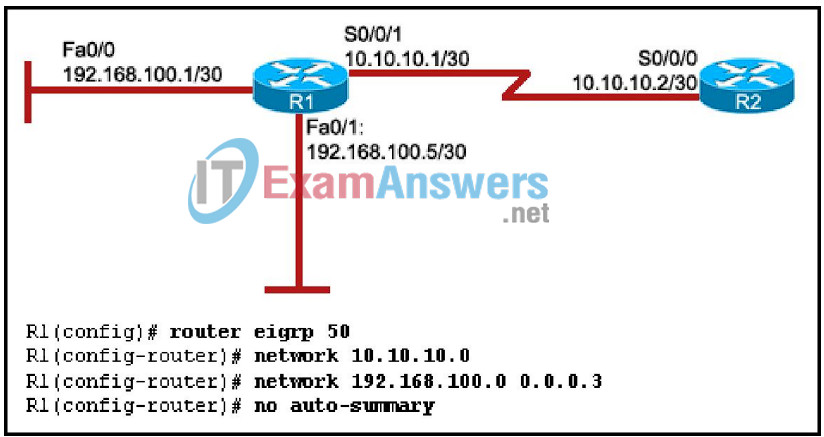
- R1 will forward the route information for subnet 192.168.100.0/30.
- The administrative distance has been set to 50 on R1.
- R1 will not forward route information for subnet 192.168.100.4/30.
- R1 will forward the EGRP update for subnet 10.10.10.0/30.
- Autosummarization must be enabled.
159. Refer to the exhibit. All routers are properly configured to use the EIGRP routing protocol with default settings, and the network is fully converged. Which statement correctly describes the path that the traffic will use from the 10.1.1.0/24 network to the 10.1.2.0/24 network?
- It will use the A-D path only.
- It will use the path A-D, and the paths A-C-D and A-B-D will be retained as the backup paths.
- It will use all the paths equally in a round-robin fashion.
- The traffic will be load-balanced between A-B-D and A-C-D.
160. A network administrator uses the RIP routing protocol to implement routing within an autonomous system. What are two characteristics of this protocol? (Choose two.)
- It uses the Bellman-Ford algorithm to determine the best path.
- It displays an actual map of the network topology.
- It offers rapid convergence in large networks.
- It periodically sends complete routing tables to all connected devices.
- It is beneficial in complex and hierarchically designed networks.
161. Refer to the exhibit. Which two components are required to complete the configuration? (Choose two.)
- a CSU/DSU device
- a DTE device
- a DCE device
- a crossover cable
- a V.35 cable
162. Refer to the exhibit. The output of the show ip route command for router R1 is displayed. What action will the router take for a packet that is destined for 192.168.1.5?
- It will drop the packet.
- It will forward the packet to interface Serial0/0/0.
- It will determine the route for the packet through a routing protocol.
- It will forward the packet to the default gateway.
163. Refer to the exhibit. All routers are running the same routing protocol. Based on the exhibit and its displayed commands, which statement is true?
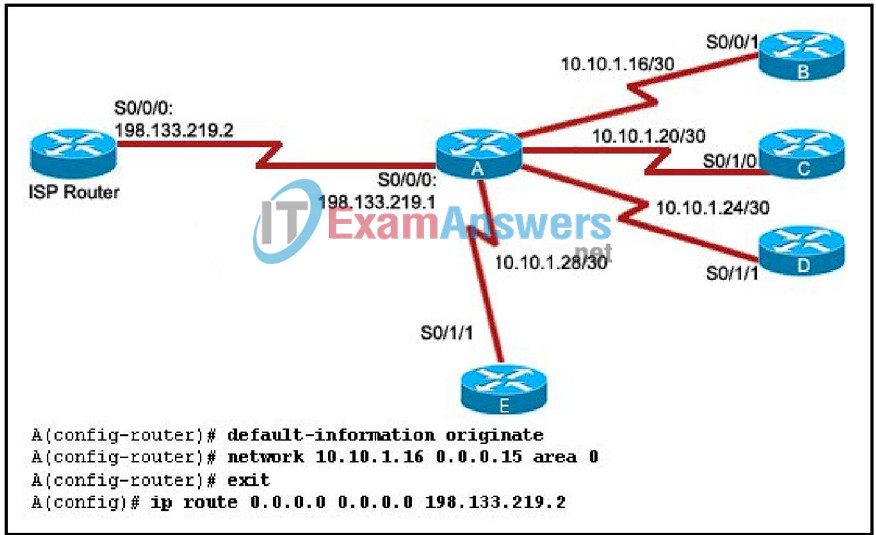
- Routers B, C, and D have no access to the Internet.
- The link to the ISP will be excluded from the routing protocol process.
- A default route must be configured on every router.
- The wildcard mask is incorrectly configured.
164. Refer to the exhibit. A network administrator is accessing router R1 from the console port. Once the administrator is connected to the router, which password should the administrator enter at the R1> prompt to access the privileged EXEC mode?
- Cisco001
- Cisco123
- Cisco789
- Cisco901
165. A router has EIGRP configured as the only routing protocol. In what way might EIGRP respond if there is no feasible successor route to a destination network and the successor route fails?
- It broadcasts hello packets to all routers in the network to re-establish neighbor adjacencies.
- It sends queries to adjacent neighbors until a new successor route is found.
- It immediately sends its entire routing table to its neighbors.
- It will set the metric for the failed route to infinity.
166. Using default settings, what is the next step in the router boot sequence after the IOS loads from flash?
- Perform the POST routine.
- Search for a backup IOS in ROM.
- Load the bootstrap program from ROM.
- Load the running-config file from RAM.
- Locate and load the startup-config file from NVRAM.
167. Refer to the exhibit. The results of the show ip route command are displayed in the graphic for Router R2. Which route will be selected for a packet with a destination address of 10.1.4.1?
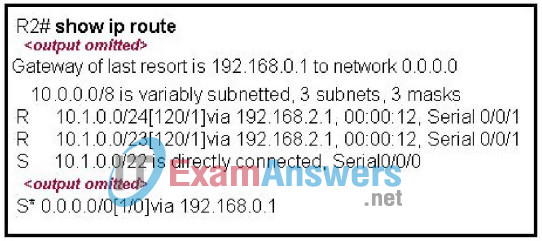
- route to 0.0.0.0/0
- route to 10.1.0.0/22
- route to 10.1.0.0/23
- route to 10.1.0.0/24
168. Which statement is true regarding routing metrics?
- All routing protocols use the same metrics.
- EIGRP uses bandwidth as its only metric.
- Routers compare metrics to determine the best route.
- The larger metric generally represents the better path.
169. Which three statements about routing protocols are true? (Choose three.)
- EIGRP supports unequal cost load balancing.
- RIP cannot be configured to allow classless routing.
- OSPF elects designated routers on multiaccess links.
- RIP does not advertise a route beyond a hop count of 15.
- EIGRP uses broadcast traffic to establish adjacencies with its neighbors.
- OSPF can convergence more quickly because it can find a feasible successor in its topology table when a successor route goes down.
170. Refer to the exhibit. A device is required to complete the connection between router R1 and the WAN. Which two devices can be used for this? (Choose two.)

- a CSU/DSU device
- a modem
- an Ethernet switch
- a hub
- a bridge
171. Which port should a terminal emulator be connected to in order to access a router without network connectivity?
- T1
- serial
- console
- FastEthernet
172. Which component is typically used to connect the WIC interface of a router to a CSU/DSU?
- V.35 cable
- RJ-45 adapter
- crossover cable
- straight-through cable
173. In which situation would a default static route be recommended?
- when connecting an edge router to the Internet
- when variable length subnet masking is in effect
- when there is more than one valid route for a destination network
- when a destination network has a larger mask than any routes in the routing table
174. Refer to the exhibit. A static route was configured on router R1 to forward packets to the remote networks. During a network upgrade, the network administrator configured RIPv2 on all routers in the network. What will router R1 do with a packet that is sourced from PC1 and destined for PC3?
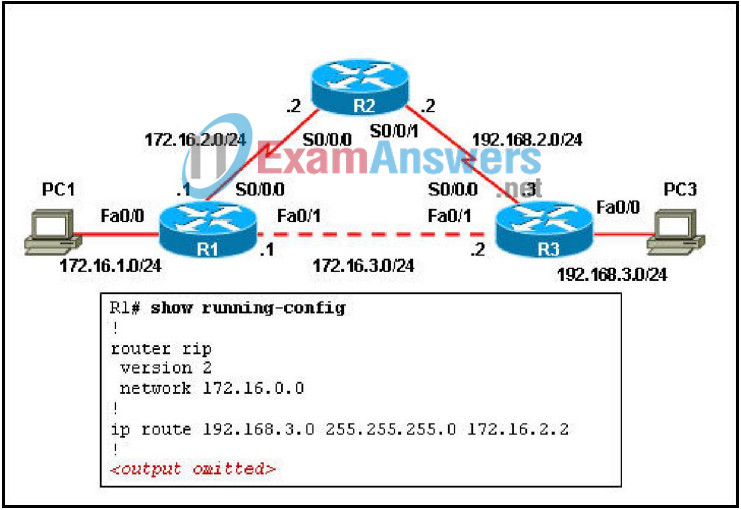
- The packet will be forwarded out the Serial0/0/0 interface via the static route.
- The packet will be forwarded out the FastEthernet0/1 interface via the static route.
- The packet will be forwarded out the Serial0/0/0 interface via the route that is learned through RIP.
- The packet will be forwarded out the FastEthernet0/1 interface via the route that is learned through RIP.
175. Refer to the exhibit. Which host has a combination of IP address and subnet mask on the same network as Fa0/0 of Router1?
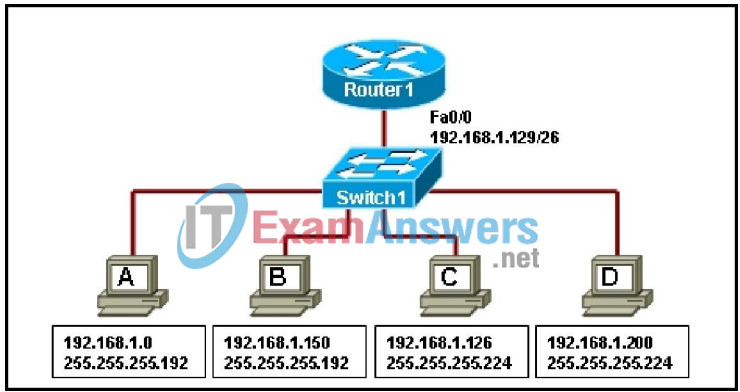
- host A
- host B
- host C
- host D
176. Refer to the exhibit. What does the highlighted entry for network 172.30.0.0/16 indicate?
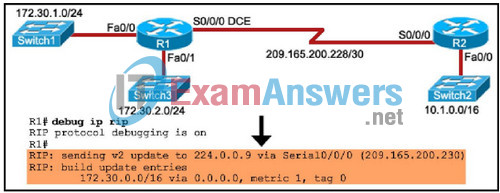
- Automatic summarization is enabled on R1.
- The routing table of R2 contains only classful networks.
- R2 will reject this update.
- The routing protocol that is configured on both routers is RIPv1.
177. Which subnetting scheme will accommodate a network of 10 LANs, each of which contains a minimum of 2000 hosts?
- 10.0.0.0/10
- 10.0.0.0/11
- 172.16.0.0/18
- 172.16.0.0/20
178. How will a router that is configured with a classless routing protocol determine the subnet mask that should be assigned to routes that are learned from neighboring classless routers?
- The subnet mask that is included in the routing updates will be used.
- The subnet mask of the interface that receives the update will be used.
- The subnet mask that is specified in the network command will be used.
- The class of the network in the update will determine the subnet mask that is used
179. Refer to the exhibit. When troubleshooting a network, it is important to interpret the output of various router commands. On the basis of the exhibit, which three statements are true? (Choose three.)
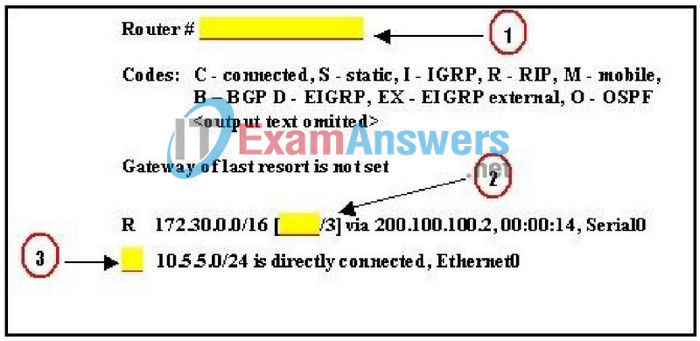
- The missing information for Blank 1 is the command show ip route.
- The missing information for Blank 1 is the command debug ip route.
- The missing information for Blank 2 is the number 100.
- The missing information for Blank 2 is the number 120.
- The missing information for Blank 3 is the letter R.
- The missing information for Blank 3 is the letter C.
180. Refer to the exhibit. PC1 is unable to access the Internet. What is the cause of the problem?
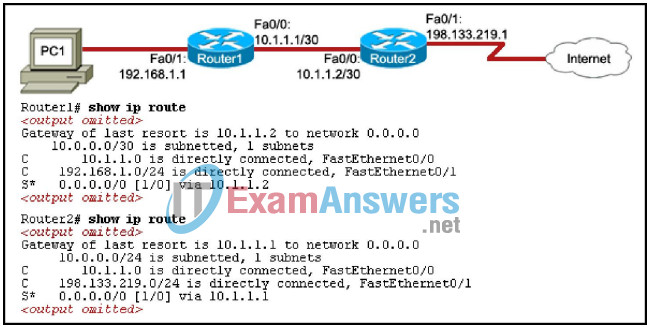
- An incorrect IP address is configured between the two routers.
- No static route is configured on Router2.
- A routing loop has occurred.
- No routing protocol is configured on either of the two routers.
181. Which mechanism helps to avoid routing loops by advertising a metric of infinity?
- route poisoning
- split horizon
- hold-down timer
- triggered updates
182. Refer to the exhibit. A packet enters Router1 with a destination IP of 172.16.28.121. Which routing table entry will be used to forward this packet to the destination address?
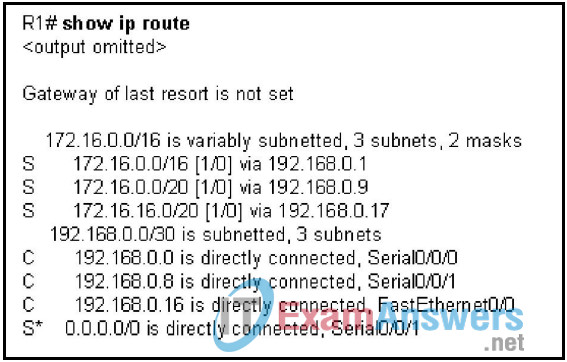
- 172.16.0.0/16 [1/0] via 192.168.0.1
- 172.16.0.0/20 [1/0] via 192.168.0.9
- 172.16.16.0/20 [1/0] via 192.168.0.17
- 0.0.0.0/0 is directly connected, Serial0/0/1
183. Refer to the exhibit. The routers in the exhibit are running the EIGRP routing protocol. What statement is true regarding how packets will travel from the 172.16.1.0/16 network to the 192.168.200.0/24 network?
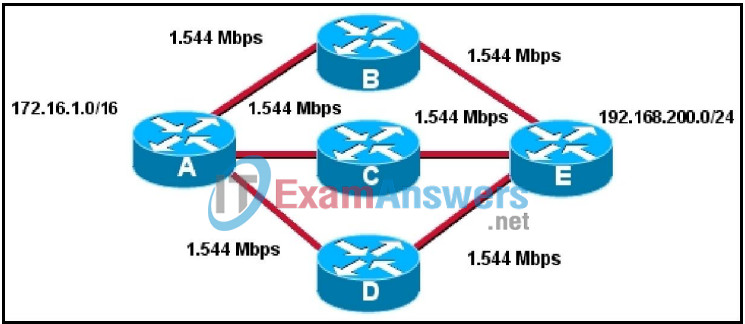
- The router chooses the first path that it learned and installs only that route in the routing table.
- The router chooses the path with the lowest administrative distance and installs only that route in the routing table.
- The router chooses the highest routing ID based on the advertised network IP addresses and installs only that route in the routing table.
- The router installs all the equal cost paths in the routing table but sends packets out only one, holding the others in reserve in case the primary route goes down.
- The router installs all the equal cost paths in the routing table and performs equal cost load balancing to send packets out multiple exit interfaces.
184. Which statement correctly describes a feasible successor in EIGRP?
- It is a primary route that is stored in the routing table.
- It is a backup route that is stored in the routing table.
- It is a primary route that is stored in the topology table.
- It is a backup route that is stored in the topology table.
185. Refer to the exhibit. A network administrator is troubleshooting the OSPF network. The 10.10.0.0/16 network is not showing up in the routing table of Router1. What is the probable cause of this problem?
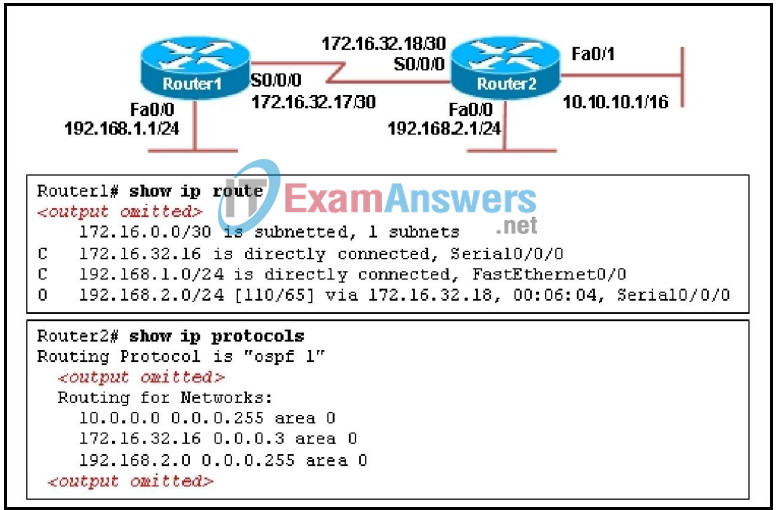
- The serial interface on Router2 is down.
- The OSPF process is not running on Router2.
- The OSPF process is configured incorrectly on Router1.
- There is an incorrect wildcard mask statement for network 10.10.0.0/16 on Router2.
186. Refer to the exhibit. If the router loopback interfaces, FastEthernet interfaces, and OSPF priorities are configured as shown, which router would win an OSPF DR election?
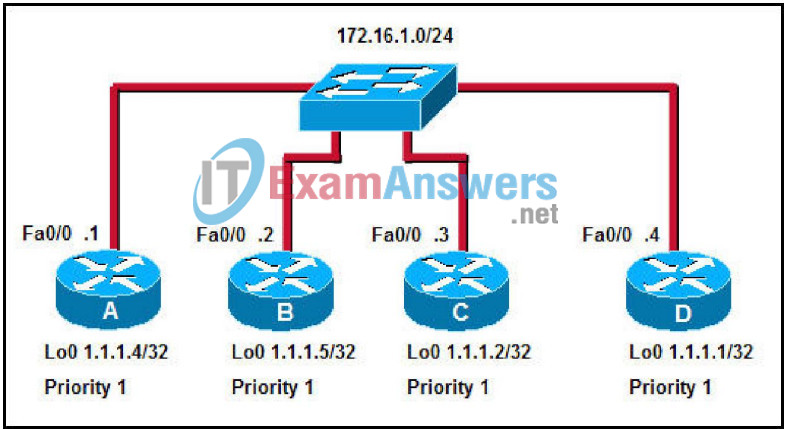
- A
- B
- C
- D
187. Refer to the exhibit. Two routers that are configured for area 0 are unable to establish neighbor adjacency. Which two configuration changes should be made to resolve this problem? (Choose two.)
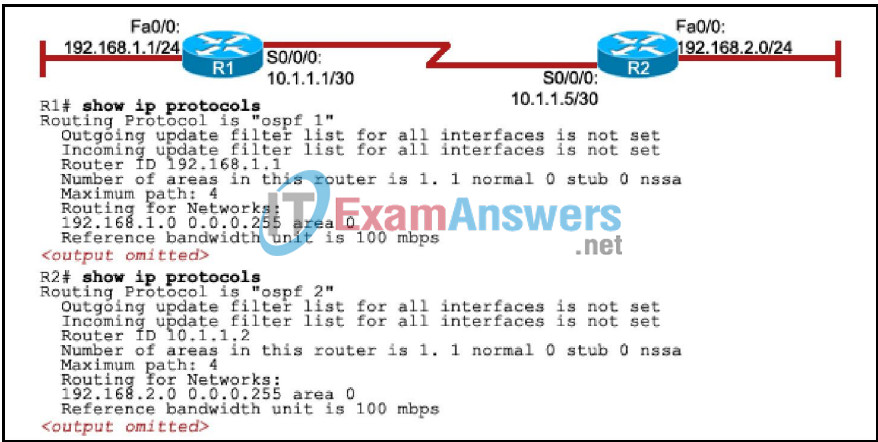
- Both the routers should be configured for the same router ID.
- The serial interface of both the routers must be configured in the same subnet.
- Both the routers should be configured as designated routers.
- Both the routers should be configured for the same process ID.
- The network 10.1.1.0 0.0.0.3 area 0 command must be issued on both routers.
188. Refer to the exhibit. A network engineer has run the show version command on R3. Upon rebooting, R3 does not load the start-up configuration settings. What could be the cause of this problem?
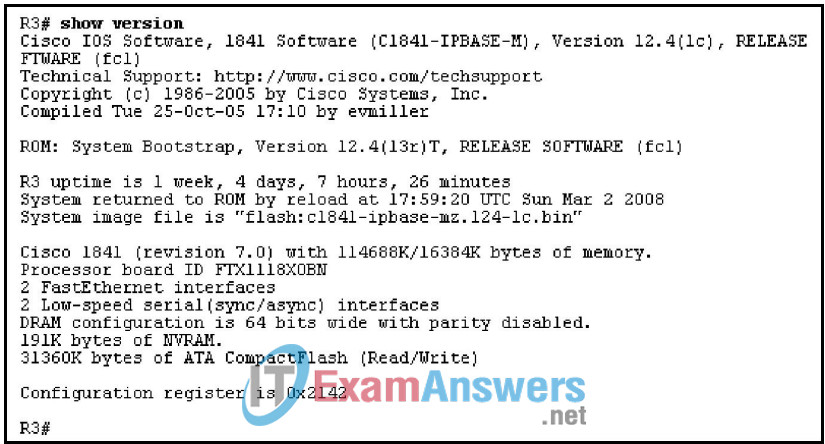
- There is insufficient NVRAM.
- There is insufficient flash memory.
- The configuration register is not configured with the default setting.
- The system image file is not located in NVRAM.
189. Which router component contains a scaled-down version of the IOS that can be used to reload a complete version of the IOS in the event that the IOS becomes damaged or corrupted?
- ROM
- Flash
- SDRAM
- NVRAM
190. Refer to the exhibit. A network administrator adds this command to router R1: ip route 192.168.2.0 255.255.255.0 S0/0/0. What is the result of adding this command?

- This route is automatically propagated throughout the network.
- The traffic for network 172.16.1.0 is forwarded to network 192.168.2.0.
- A static route is established.
- The traffic for all Class C networks is forwarded to 172.16.1.2.
191. Refer to the exhibit. How many routes are ultimate routes?
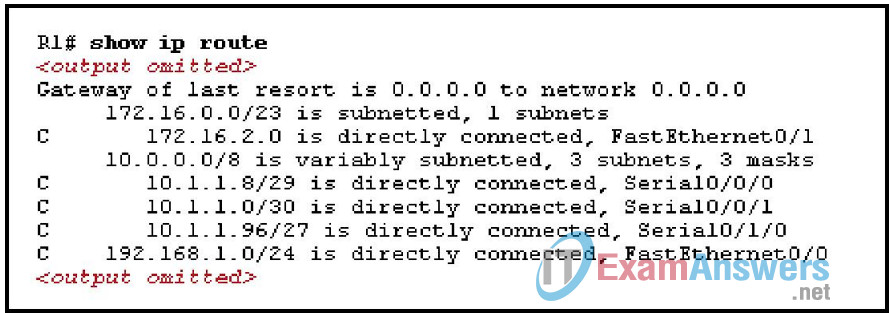
- 3
- 4
- 5
- 7
192. Refer to the exhibit. The router receives a packet that is destined for 192.168.5.79. How will the router handle this packet?
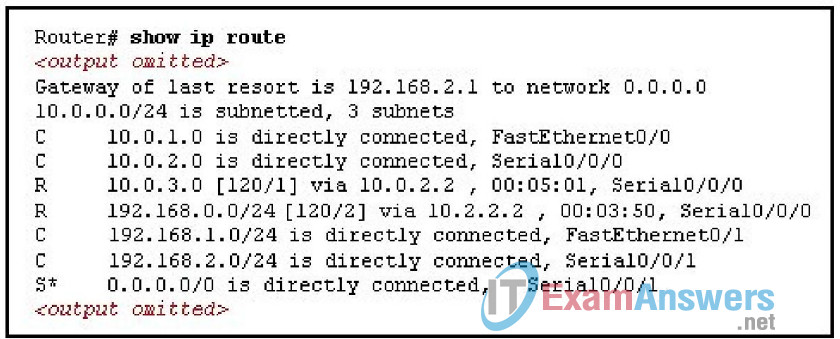
- It will forward the packet via the FastEthernet0/0 interface.
- It will forward the packet via the Serial0/0/0 interface.
- It will forward the packet via the Serial0/0/1 interface.
- It will drop the packet.
193. Refer to the exhibit. What is the meaning of the highlighted value 120?
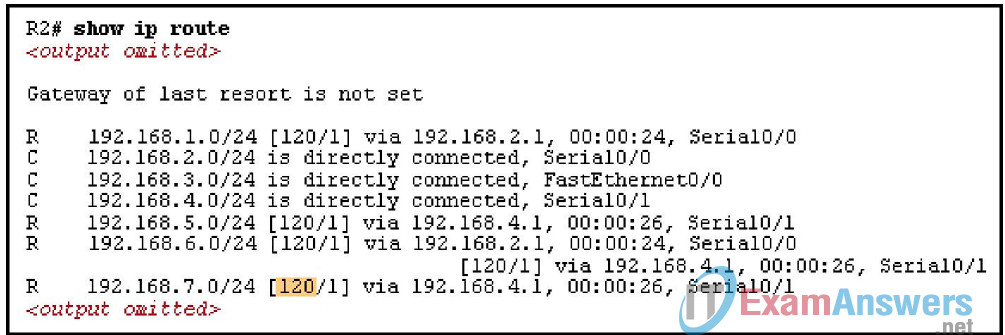
- It is the metric that is calculated by the routing protocol.
- It is the value that is used by the DUAL algorithm to determine the bandwidth for the link.
- It is the administrative distance of the routing protocol.
- It is the hold-down time, measured in seconds, before the next update.
194. When presented with multiple valid routes to a destination, what criteria does a router use to determine which routes to add to the routing table?
- The router selects the routes with the best metric. All routes that have the same best metric are added to the routing table.
- The router first selects routes with the lowest administrative distance. The resulting routes are then prioritized by metric and the routes with the best metric are added to the routing table.
- The router selects the routes with the lowest administrative distance. All routes with the same lowest administrative distance are added to the routing table.
- The router installs all routes in the routing table but uses the route with the best metric most when load balancing.
195. Refer to the exhibit. When a static IP address is being configured on the host, what address should be used for the default gateway?
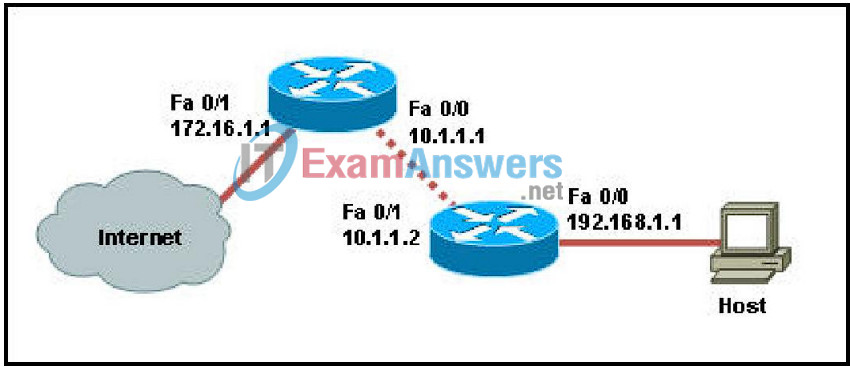
- 10.1.1.1
- 10.1.1.2
- 172.16.1.1
- 192.168.1.1
196. Refer to the exhibit. A network administrator accesses router R1 from the console port to configure a newly connected interface. What passwords will the network administrator need to enter to make the connection and the necessary configuration changes?
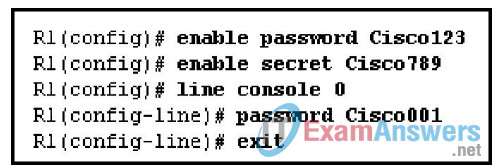
- the Cisco123 password only
- the Cisco789 password only
- the Cisco001 password only
- the Cisco001 password and the Cisco789 passwords
- the Cisco001 password and the Cisco123 passwords
197. Refer to exhibit. A company network engineer enters the following commands in the routers:
R1(config)# ip route 10.1.1.0 255.255.255.0 192.168.0.2 R2(config)# ip route 10.1.2.0 255.255.255.0 192.168.0.1
When the engineer enters the show ip route command on R1, the routing table does not display the static route to the 10.1.1.0 network. All R1 and R2 interfaces are correctly addressed per the graphic. What is a logical next step that the engineer could take in order to make the static route display in the routing table in R1?
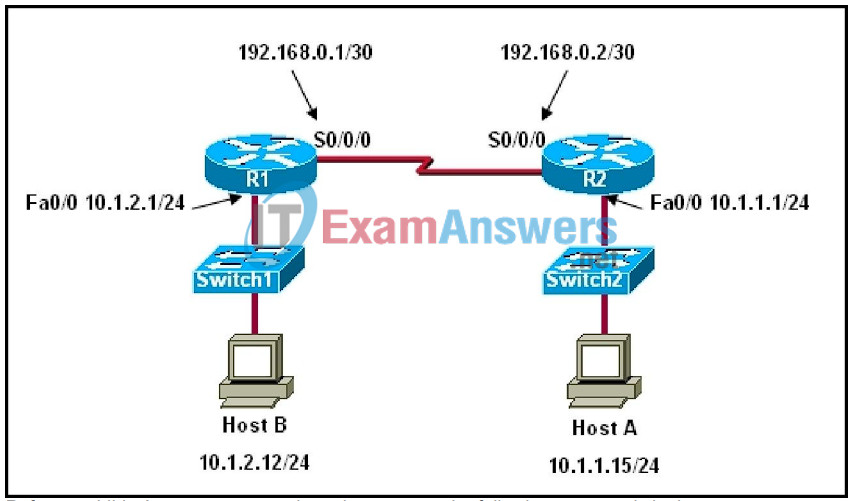
- Enter default routes in R1 and R2.
- Enable the R1 and R2 serial interfaces.
- Configure the static route to use an exit interface instead of a next-hop address.
- Enter the copy run start command to force the router to recognize the configuration.
198. Refer to the exhibit. The show cdp neighbors command was run on one of the devices as shown. Based on this information, which two facts can be determined? (Choose two.)

- The command was run on the router.
- ABCD is a non- CISCO device.
- Layer 3 connectivity between two devices exists.
- ABCD supports routing capability.
- ABCD is connected to the Fa0/0 interface of the neighboring device.
199. The network administrator configures the router with the ip route 172.16.1.0 255.255.255.0 172.16.2.2 command. How will this route appear in the routing table?
- C 172.16.1.0 is directly connected, Serial0/0
- S 172.16.1.0 is directly connected, Serial0/0
- C 172.16.1.0 [1/0] via 172.16.2.2
- S 172.16.1.0 [1/0] via 172.16.2.2
200. A company is using static routes that are configured with an administrative distance of “1” on all routers in the network. The network administrator decides to introduce a dynamic routing protocol to reduce the manual configurations for the static routes. Which option identifies the correct procedure for the dynamic routing to take place in the network?
- The static routes and the dynamic routes will have the traffic alternate between them.
- The static routes will be automatically removed once the dynamic routing is configured.
- The static routes will be automatically updated with the next hop IP address once the dynamic routing is configured.
- The static routes must be manually removed from all routers in order for the dynamic routes to be installed in the routing table.
201. Refer to the exhibit. What summarization should R2 use to advertise its LAN networks to R1?
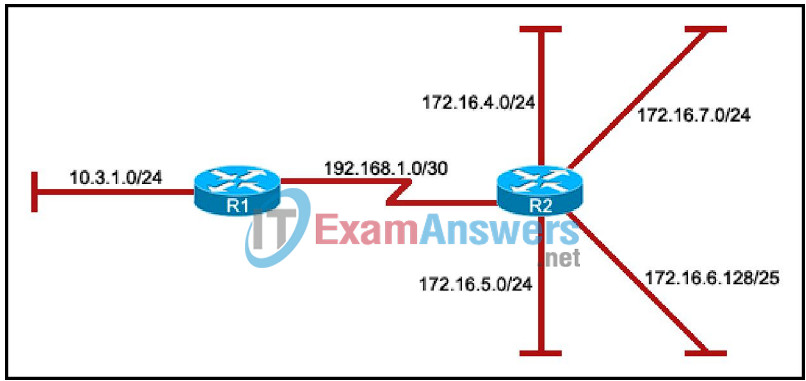
- 172.16.0.0/24
- 172.16.4.0/22
- 172.16.4.0/23
- 172.16.4.0/24
202. Refer to the exhibit. The network is using the RIPv2 routing protocol. If network 10.0.0.0 goes down, what mechanism will prevent Router1 from advertising false routing information back to Router2?
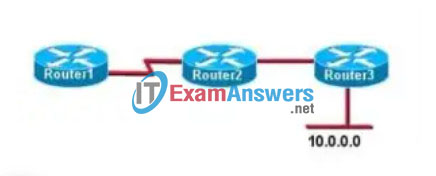
- triggered updates
- poison reverse
- holddown timers
- split horizon
203. Refer to the exhibit. When the show cdp neighbors command is issued from router C, which devices will be displayed in the output?
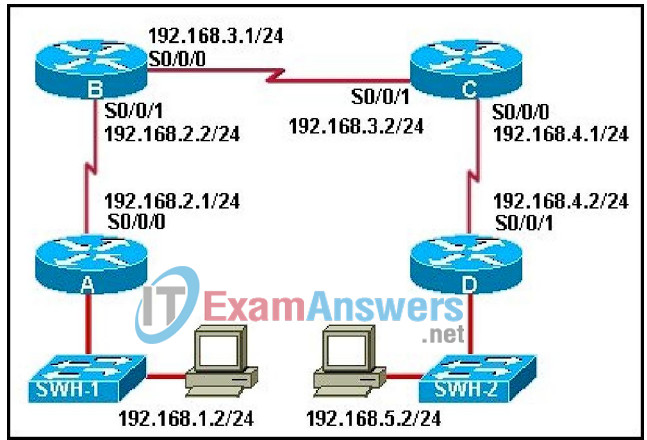
- B, D
- A, B, D
- D, SWH-2
- SWH-1, A, B
- SWH-1, SWH-2
- A, B, D, SWH-1, SWH-2
204. Refer to the exhibit. OSPF is used for the routing protocol and all interfaces are configured with the correct IP addresses and subnet masks. During testing, it is found that router R1 is unable to form an adjacency with R2. What is the cause of this problem?
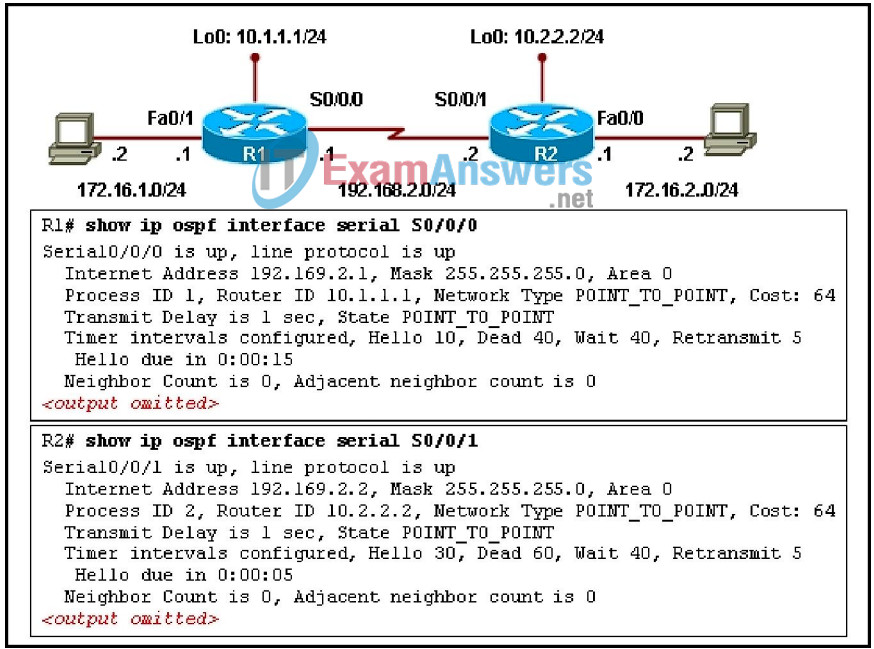
- Both routers have been configured with incorrect router IDs.
- Both routers have been configured in different OSPF areas.
- Both routers have been configured with an incorrect network type.
- Both routers have been configured with different hello and dead intervals.
205. Refer to the exhibit. The IP addresses on all interfaces on router R1 were configured before the OSPF protocol had been enabled on the router. No OSPF router ID was manually configured. Which IP address will be selected by the router as an OSPF router ID?
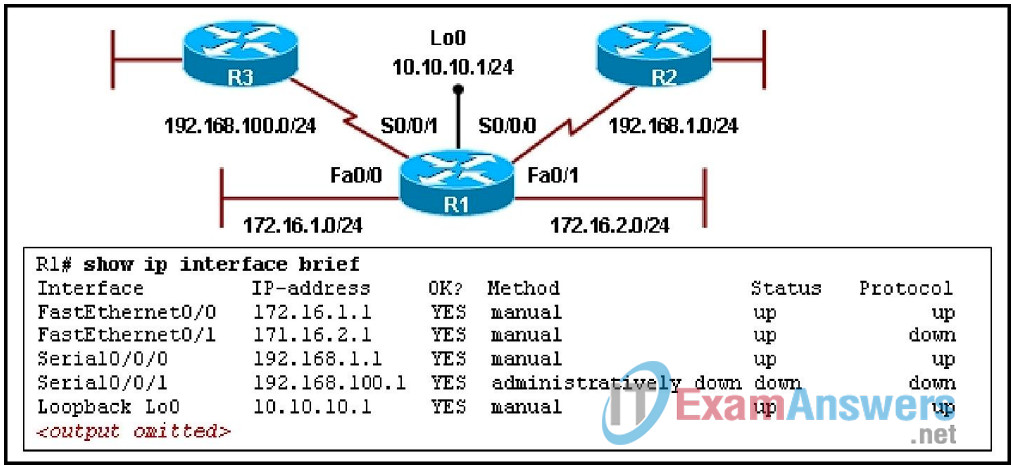
- 10.10.10.1
- 172.16.1.1
- 172.16.2.1
- 192.168.1.1
- 192.168.100.1
206. Refer to the exhibit. Router R1 receives a packet for destination 192.168.1.10. Which route will be preferred for this packet?
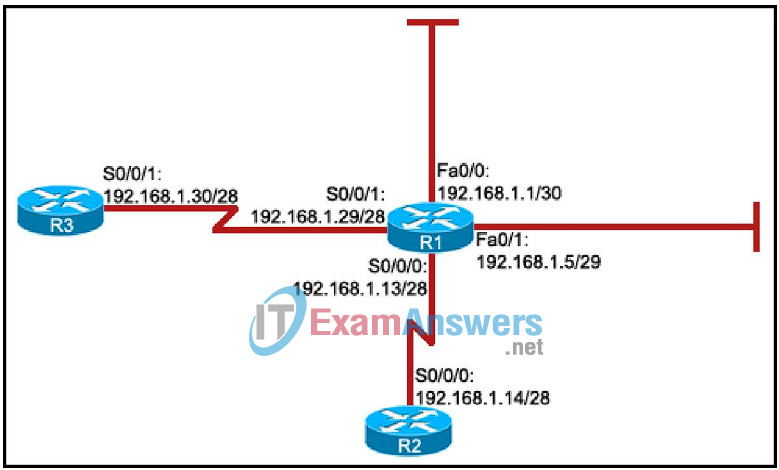
- through the Fa0/0 interface
- through the Fa0/1 interface
- through the S0/0/0 interface
- through the S0/0/1 interface
207. Refer to the exhibit. Which two routes are level 1 ultimate routes? (Choose two.)
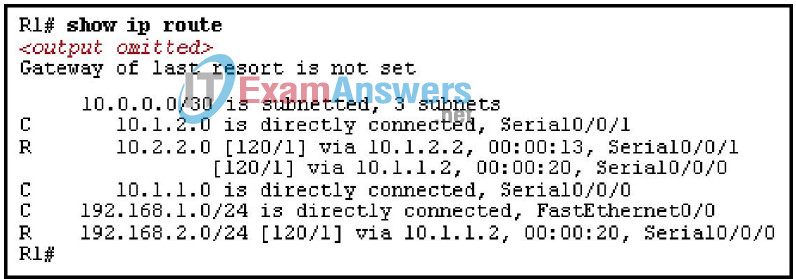
- 10.0.0.0
- 10.1.2.0
- 10.2.2.0
- 10.1.1.0
- 192.168.1.0
- 192.168.2.0
208. Which routing protocol by default uses bandwidth and delay to calculate the metric of a route?
- RIPv1
- RIPv2
- OSPF
- EIGRP
209. Refer to the exhibit. RIPv1 has been used as a routing protocol on the network. A new 172.16.2.0/24 network has been added on router R2 and configured under the RIP routing process. When will R1 converge?
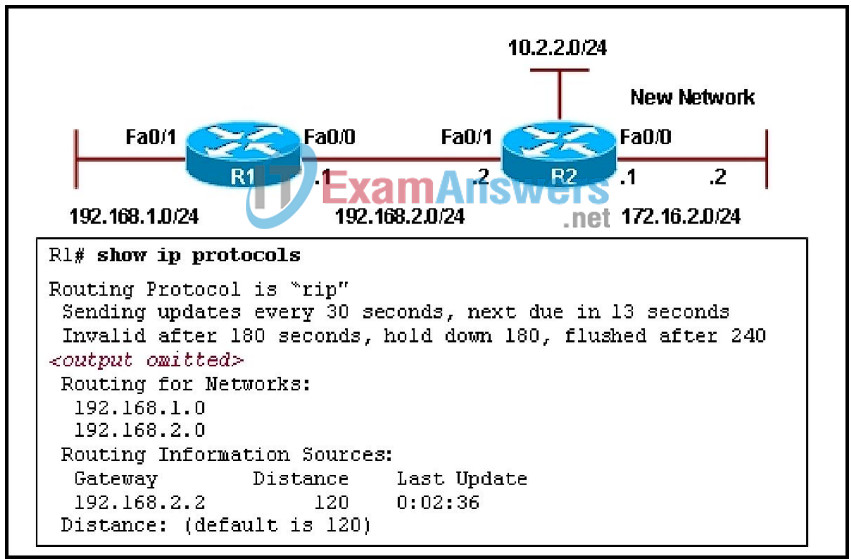
- after 13 seconds
- after 30 seconds
- after 180 seconds
- after R1 receives triggered updates from R2
210. Which two statements are true for OSPF Hello packets? (Choose two.)
- They are used for dynamic neighbor discovery.
- They are used to maintain neighbor relationships.
- They are used to determine the complete network topology.
- They are used with timers to elect the designated router with the fastest link.
- They are used to negotiate correct parameters among neighboring interfaces.
211. An administrator is configuring Router1 so that it can connect to Router2 by using IP. Which protocol can be used by Router1 to determine the IP address of Router2 when they are directly connected and only Layer 2 connectivity exists between them?
- ARP
- CDP
- ICMP
- Telnet
212. What can be determined from the output shown in the exhibit? (Choose two.)

- Annapolis is a 2611 router that is connected to the S0/0 interface of the Montgomery router.
- All of the routers are connected to Montgomery through an Ethernet switch.
- Montgomery has Layer 2 connectivity with Cumberland.
- Layer 3 connectivity is operational for all of the devices listed in the Device ID column.
- An administrator consoled into the Waldorf router can ping the Brant router.
- Brant, Fisherman, and Potomac are directly connected to Montgomery.
213. Refer to the exhibit. Which route in the routing table of R1 will be discarded by its neighboring router?
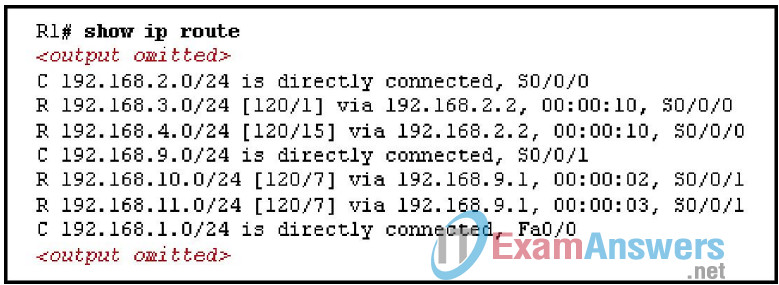
- 192.168.2.0
- 192.168.3.0
- 192.168.4.0
- 192.168.9.0
- 192.168.10.0
- 192.168.11.0
214. Refer to the exhibit. Which combination of network ID and subnet mask can be used to meet the 24 host requirement of the LAN that is attached to Router3?
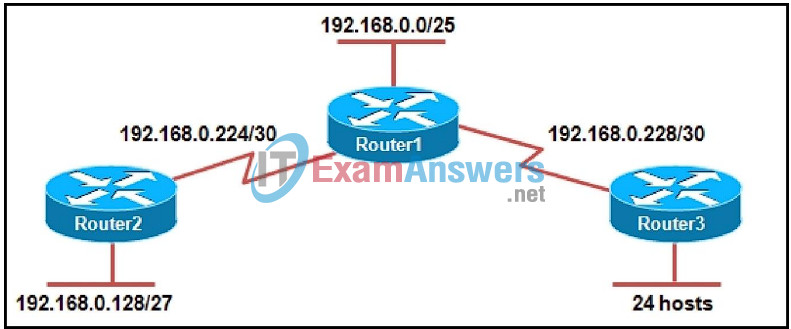
- 192.168.0.0/27
- 192.168.0.64/26
- 192.168.0.192/26
- 192.168.0.192/27
215. Refer to the exhibit. The networks that are connected to R1 have been summarized for R2 as 192.168.136.0/21. Which packet destination address will R2 forward to R1?
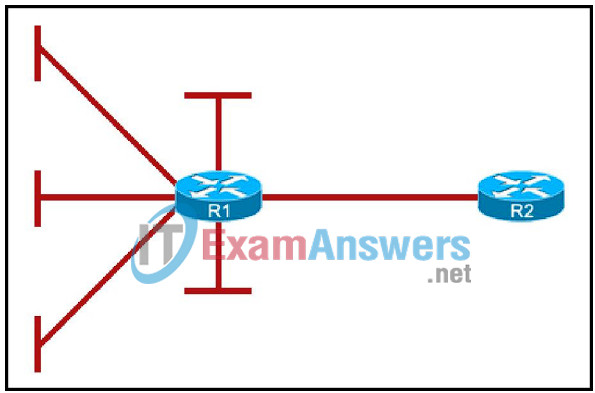
- 192.168.135.1
- 192.168.142.1
- 192.168.144.1
- 192.168.128.1
216. A network administrator has been asked to configure a network using a classful IP addressing scheme. Which statement is true about the IP addressing that will be used?
- Classful IP addresses can be used only when static routing is configured in the network.
- Classful IP addresses allow the network/host boundary to occur at any bit in the 32-bit address.
- The subnet mask for classful IP addresses can be determined by the value of the first octet of the IP address.
- Classful IP addresses require the subnet mask to be included in the routing updates that are propagated by the classful routing protocols.
217. Which range of IP addresses will be used by RIPv2, EIGRP, and OSPF routing protocols to send routing advertisements?
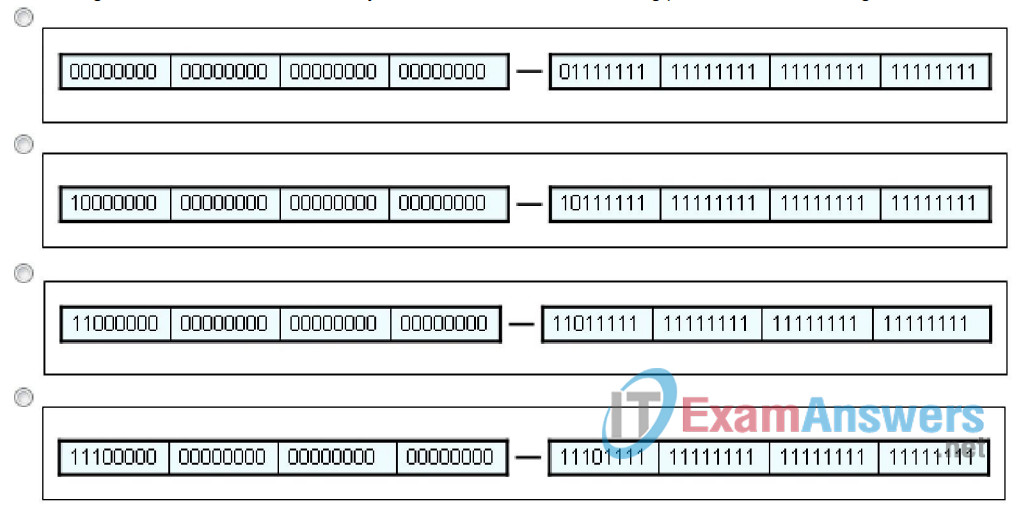
- Option 1
- Option 2
- Option 3
- Option 4
218. Refer to the exhibit. All routers are configured with RIPv2 active on all interfaces. Automatic summarization is in effect. Why does the routing table on R3 include the 209.165.200.228/30 network but not the 172.30.1.0/24 and 172.30.2.0/24 networks?
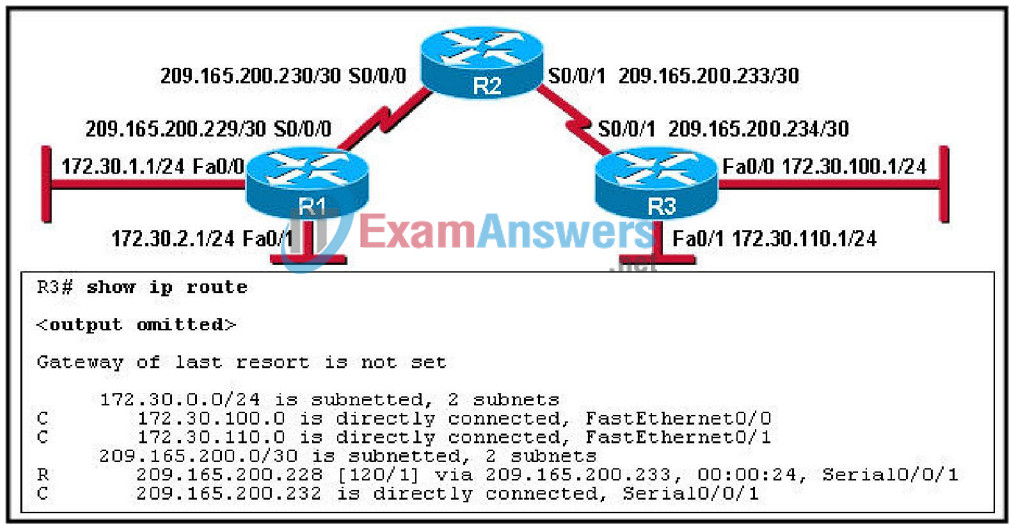
- CIDR is required to route supernets.
- There is no default gateway configured.
- The 172.30.0.0/16 subnets are discontiguous.
- RIPv2 cannot route networks with variable subnets.
219. Refer to the exhibit. What will happen if interface Serial0/0/1 goes down on Router1?
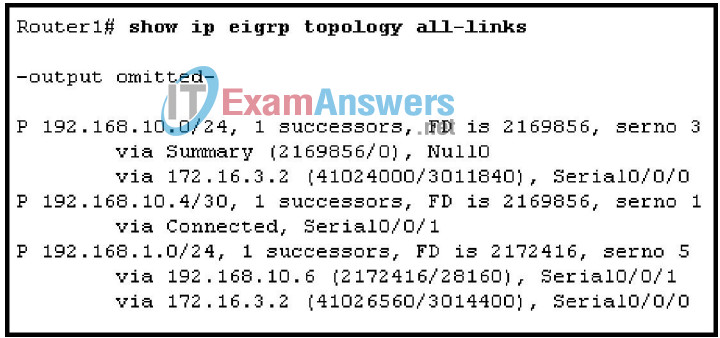
- The Dijkstra algorithm will calculate the feasible successor.
- DUAL will query neighbors for a route to network 192.168.1.0.
- Neighbor 172.16.3.2 will be promoted to the feasible successor.
- Traffic destined to the 192.168.1.0 network will be dropped immediately due to lack of a feasible successor.
220. Refer to the exhibit. All routers are configured for OSPF area 0. The network administrator requires that R2 always be the DR and maintain adjacency. Which two configurations can achieve this? (Choose two.)
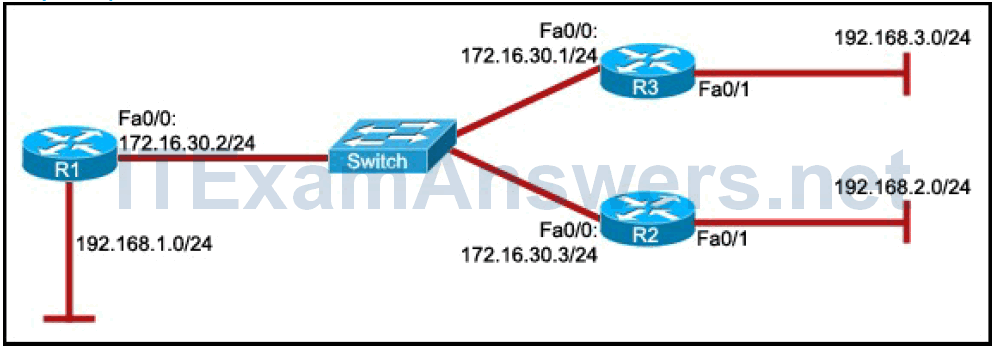
- Change the OSPF area of R2 to a higher value.
- Change the router ID for R2 by assigning the IP address 172.16.30.5/24 to the Fa0/0 interface.
- Change the priority values of the Fa0/0 interfaces of R1 and R3 to 0.
- Configure a loopback interface on R2, with an IP address higher than any IP address on the other routers.
- Configure R1 and R3 with an IP address whose value is higher than that of R2.
221. Which of the following could describe the devices labeled “?” in the graphic? (Choose three.)

- DCE
- CSU/DSU
- LAN switch
- modem
- hub
222. Refer to the exhibit. What happens to a packet that has 172.16.0.0/16 as the best match in the routing table that is shown?

- The packet is discarded.
- The packet is flooded out all interfaces.
- The packet is forwarded via Serial0/0/0.
- The packet is forwarded via FastEthernet0/0.
223. The network shown in the diagram is having problems routing traffic. It is suspected that the problem is with the addressing scheme. What is the problem with the addressing used in the topology?
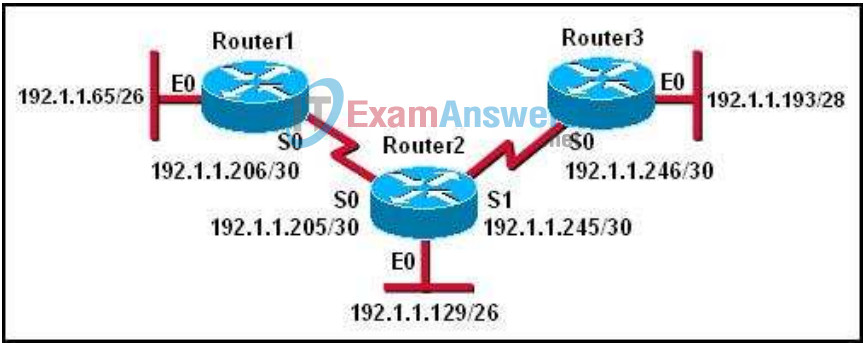
- the address assigned to the Ethernet 0 interface of Router1 is a broadcast address for that subnetwork
- the subnetwork configured on the serial link between Router1 and Router2 overlaps with the subnetwork assigned to Ethernet 0 of Router3
- the subnetwork assigned to the Serian 0 interface of Router1 is on a different subnetwork from the address for Serial 0 of Router2
- the subnetwork assigned to Ethernet 0 of Router2 overlaps with the subnetwork assigned to Ethernet 0 of Router 3
224. Refer to the exhibit. Which route will be removed from the routing table if manual EIGRP summarization is disabled the Serial0/0/0 interface of R3?
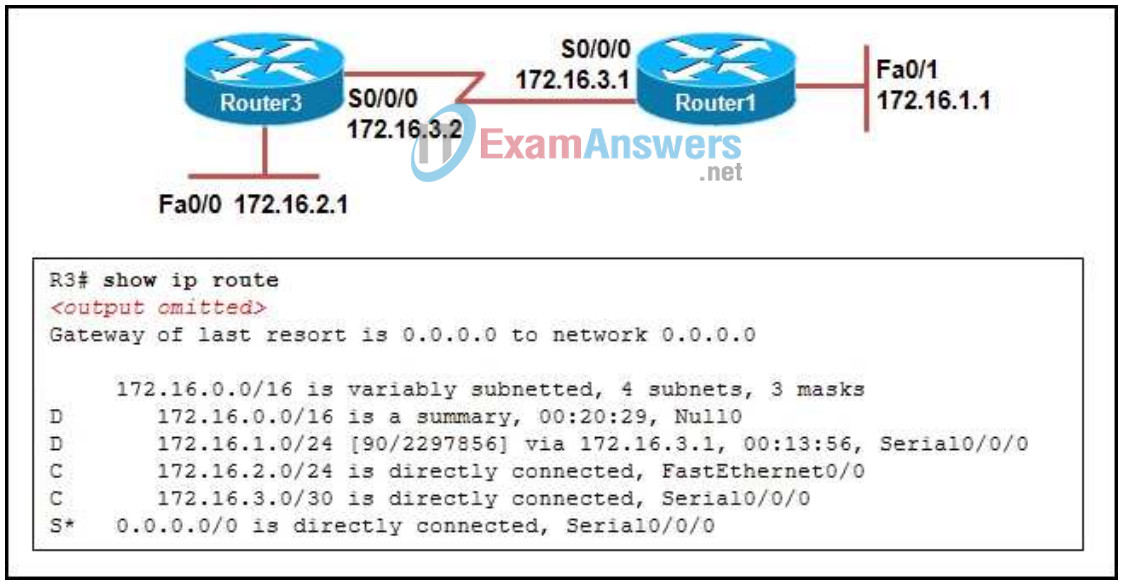
- 0.0.0.0/0
- 172.16.0.0/16
- 172.16.1.0/24
- 172.16.3.0/30
225. What happens if an EIGRP network path fails and DUAL cannot locate a suitable successor?
- Routing cannot continue because there is no path to that network.
- The backup table will be searched.
- DUAL will put the router into the active state.
- All packets going to that network will be routed to the default gateway instead.
- All packets going to that network will be dropped.
226. Refer to the exhibit. Hosts on the BOS Fa0/0 LAN are able to ping the Fa0/1 interface on the JAX router and all interfaces on the BOS and ORL routers. Why would hosts from the 10.0.0.0/24 network not be able to ping hosts on the Fa0/0 LAN of the JAX router?

- The JAX router has the wrong process ID.
- The JAX router needs the network 10.0.0.0 0.0.0.255 area 0 command.
- The JAX router needs the network 192.168.3.0 0.0.0.255 area 0 command.
- The BOS router needs the network 192.168.3.0 0.0.0.255 area 0 command.
227. What does RIP use to reduce convergence time in a larger network?
- It uses multicast instead of broadcast to send routing updates.
- It reduces the update timer to 15 seconds if there are more than 10 routes.
- It uses triggered updates to announce network changes if they happen in between the periodic updates.
- It uses random pings to detect if a pathway is down and therefore is preemptive on finding networks that are down.
228. If a router is booting with its default configuration register setting and its NVRAM lacks boot system commands, from where will the router try to load the IOS image first?
- ROM
- RAM
- NVRAM
- flash
- TFTP server
229. On a router, which actions can be performed in user mode?
- perform password recovery
- make global configuration changes
- view current router configuration
- make changes to a specified interface
230. Refer to the exhibit. What are the effects of the exhibited commands on the router?

- All passwords are encrypted.
- Only Telnet sessions are encrypted.
- Only the enable password is encrypted.
- Only the enable password and Telnet session are encrypted.
- Enable and console passwords are encrypted.
231. A network administrator has configured a default route on Router_A but it is not being shared with adjacent Router_B and the other routers in the OSPF area. Which command will save the administrator the time and trouble of configuring this default route on Router_B and all of the other routers in the OSPF area?
- Router_A(config-router)# ospf redistribute default-route
- Router_B(config-router)# ospf redistribute default-route
- Router_A(config-router)# default-information originate
- Router_B(config-router)# default-information originate
- Router_A(config-router)# ip ospf update-default
- Router_B(config-router)# ip ospf update-default
232. Refer to the exhibit. The hosts that are connected to RTRB are not able to reach hosts connected to RTRA. Based on the configuration, what could be the problem?
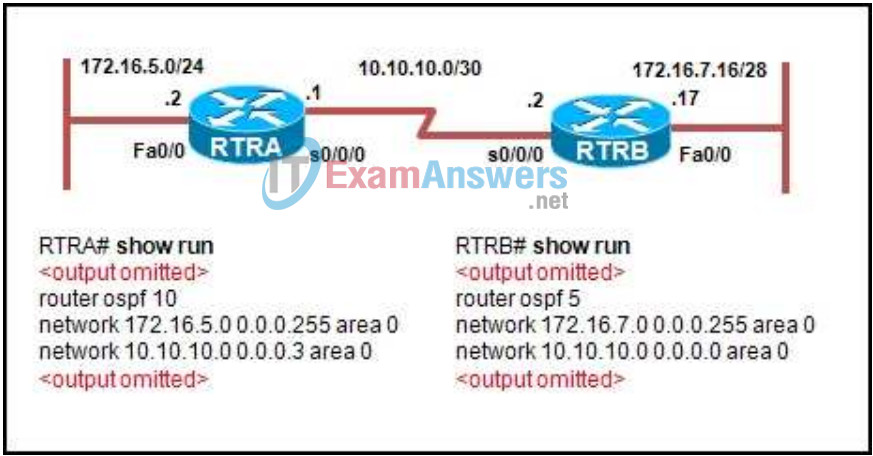
- The OSPF process IDs do not match.
- The command network 10.10.10.0 0.0.0.3 area 0 on RTRA is incorrect.
- The command network 10.10.10.0 0.0.0.0 area 0 on RTRB is incorrect.
- The command network 172.16.7.0 0.0.0.255 area 0 on RTRB is incorrect.

Hi, thank you for all your researching time but is there a way to get all the missing images? I mean the exibit pictures!
Thank you very much!
this answer keys are the updated version of CCNA2 as of October 15, 2014..
I spent hours searching for this.
got 100%
:P too many question but whats the order ? is 2013 year question is on the top or down… plz help i got exam this sunday
Curious, Why are the questions out of order? and how can i tell the difference between 2013 and 2014 Answers.